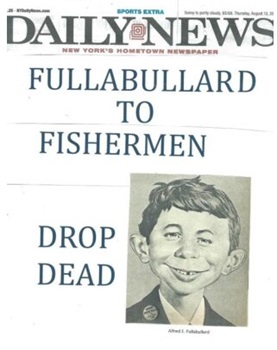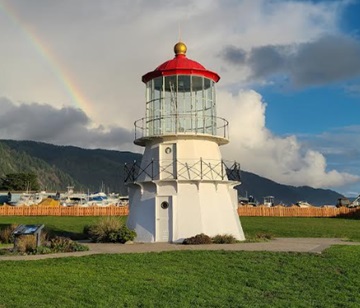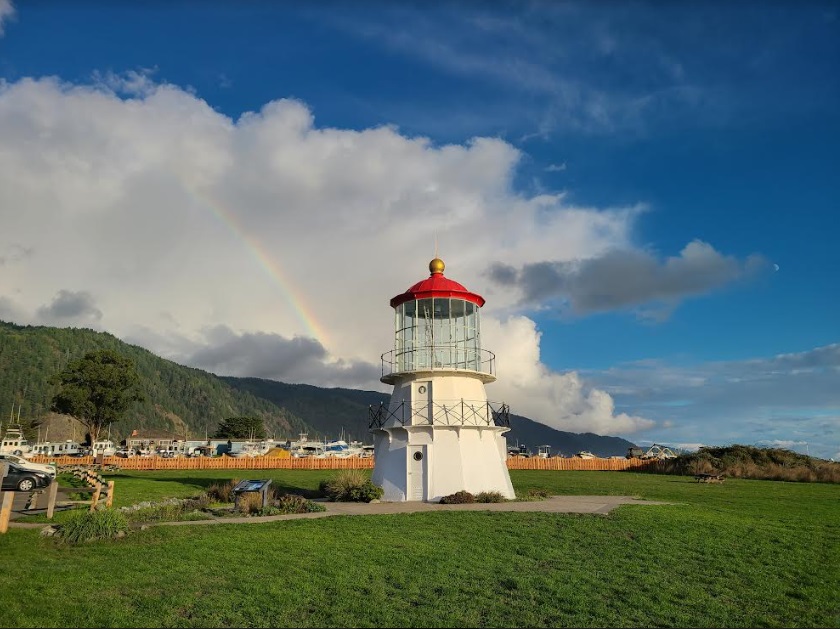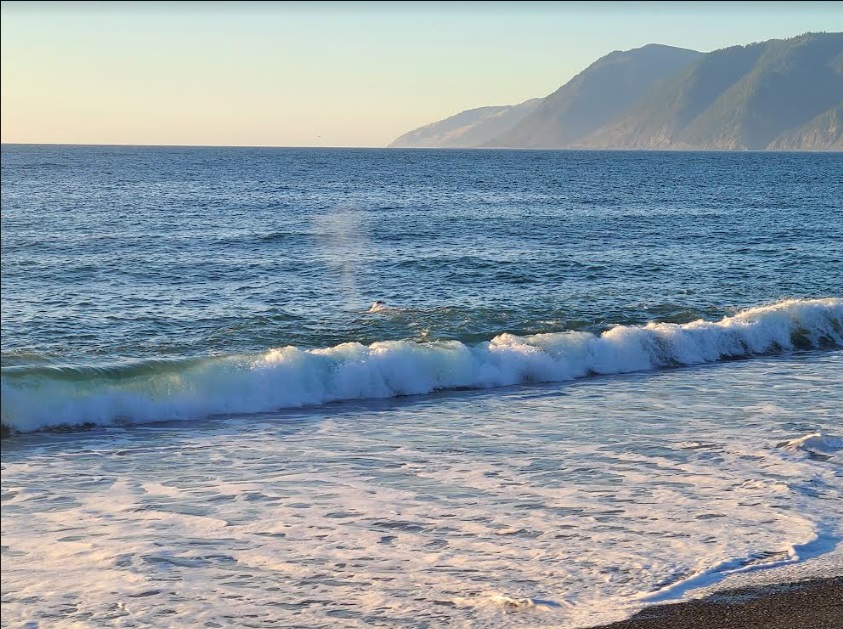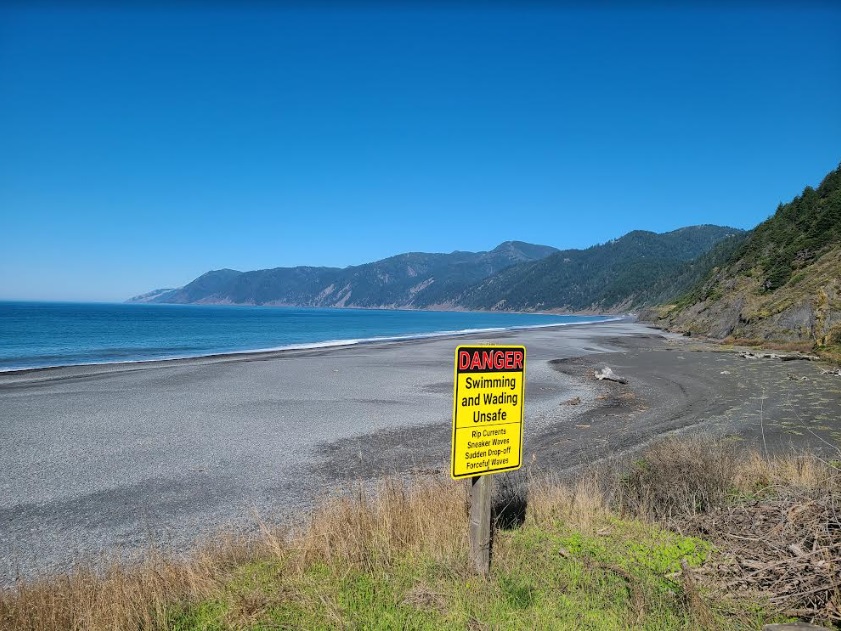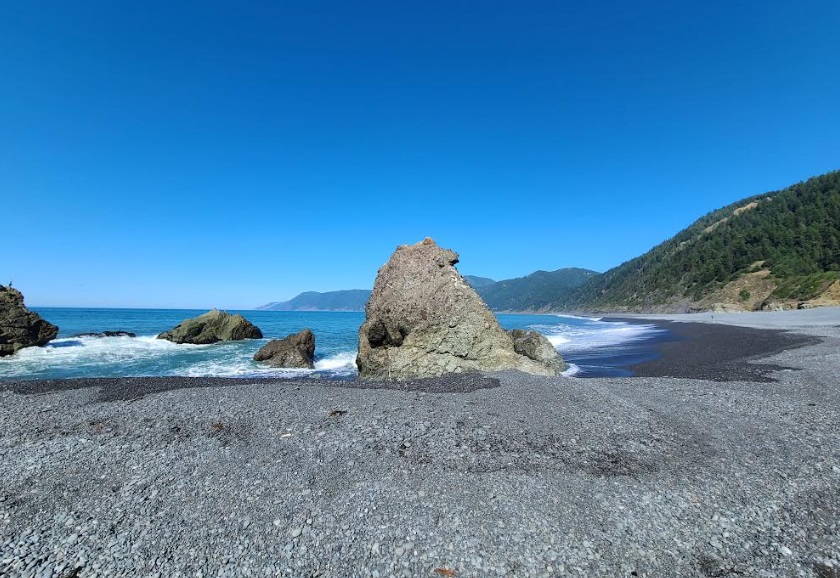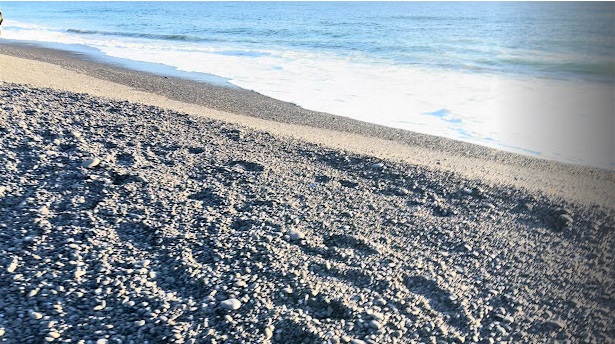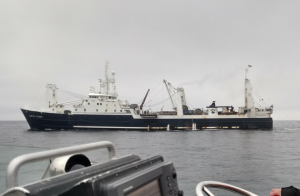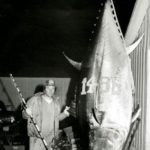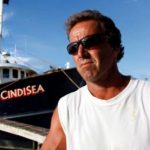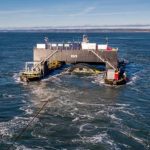Search Results for: Jim Lovgren
IS THE G.A.O. SLOWWALKING ITS INVESTIGATION OF OFFSHORE WIND IMPACTS? By Jim Lovgren
 On June 15, 2023, Congressman Chris Smith issued a press release touting the acceptance by the General Accountability Office [GAO], of a request by the House Natural Resources Committee to investigate a wide range of issues related to the development of offshore wind. The Committee letter, signed by Chairman Bruce Westerman, was submitted on May 15 th , 2023, almost a year ago. I bring this up because the average time-length of most GAO investigations is three months. Which begs the question; Is the Biden administration “slow-walking” the GAO investigation? Slow-walking is the act of purposefully delaying action by stalling, stonewalling, making excuses of how hard it is to do, and other whiney efforts at delaying an investigation until it fails because it is too late. It is the bureaucrat’s favorite weapon of choice when forced to disclose vital information, that their politician benefactors don’t want exposed. more, >>click to read<< 06:10
On June 15, 2023, Congressman Chris Smith issued a press release touting the acceptance by the General Accountability Office [GAO], of a request by the House Natural Resources Committee to investigate a wide range of issues related to the development of offshore wind. The Committee letter, signed by Chairman Bruce Westerman, was submitted on May 15 th , 2023, almost a year ago. I bring this up because the average time-length of most GAO investigations is three months. Which begs the question; Is the Biden administration “slow-walking” the GAO investigation? Slow-walking is the act of purposefully delaying action by stalling, stonewalling, making excuses of how hard it is to do, and other whiney efforts at delaying an investigation until it fails because it is too late. It is the bureaucrat’s favorite weapon of choice when forced to disclose vital information, that their politician benefactors don’t want exposed. more, >>click to read<< 06:10
IS THE G.A.O. SLOWWALKING ITS INVESTIGATION OF OFFSHORE WIND IMPACTS? By Jim Lovgren
 On June 15, 2023, Congressman Chris Smith issued a press release touting the acceptance by the General Accountability Office [GAO], of a request by the House Natural Resources Committee to investigate a wide range of issues related to the development of offshore wind. The Committee letter, signed by Chairman Bruce Westerman, was submitted on May 15 th , 2023, almost a year ago. I bring this up because the average time-length of most GAO investigations is three months. Which begs the question; Is the Biden administration “slow-walking” the GAO investigation? Slow-walking is the act of purposefully delaying action by stalling, stonewalling, making excuses of how hard it is to do, and other whiney efforts at delaying an investigation until it fails because it is too late. It is the bureaucrat’s favorite weapon of choice when forced to disclose vital information, that their politician benefactors don’t want exposed.
On June 15, 2023, Congressman Chris Smith issued a press release touting the acceptance by the General Accountability Office [GAO], of a request by the House Natural Resources Committee to investigate a wide range of issues related to the development of offshore wind. The Committee letter, signed by Chairman Bruce Westerman, was submitted on May 15 th , 2023, almost a year ago. I bring this up because the average time-length of most GAO investigations is three months. Which begs the question; Is the Biden administration “slow-walking” the GAO investigation? Slow-walking is the act of purposefully delaying action by stalling, stonewalling, making excuses of how hard it is to do, and other whiney efforts at delaying an investigation until it fails because it is too late. It is the bureaucrat’s favorite weapon of choice when forced to disclose vital information, that their politician benefactors don’t want exposed.
The General Accountability Office is the investigative arm of Congress, similar to Internal Affairs investigators, and is known as the Congressional Watchdog. It is considered the most impartial branch of the Federal Government and they produce about nine hundred reports annually, covering every aspect of government, especially the operation of various government agencies and departments. The GAO is led by the Comptroller General of the U.S. Gene Dodaro, who was officially appointed by President Obama in 2010 to a fifteen-year non-renewable term. Before that he was the Acting Comptroller General, being appointed by President George Bush in 2008, he enjoys non-partisan support among both parties. So why has this offshore wind investigation taken so long? These are professional investigators and they have dealt with a number of Wind farm issues in the past, as recently as their report from 2020 on the need for ignoring the long historied Jones Act so that foreign made vessels can steal American jobs, because the US doesn’t have readily available vessels to do the work.
Perhaps the problem with the investigation was the scope of what was asked of the GAO by the Committee, with Congressman Smith joined by Congressman Jeff Van Drew, and Congressman Andy Harris of Maryland, all of whom represent coastal districts. The investigation was initiated because of the unusual number of marine mammals strandings that were taking place all along the east coast starting in December 2022 that enraged the average shore citizen and enlightened them to the carnage that was just beginning. The most important concern of the general public was; is the offshore wind survey work responsible for the marine mammal massacre taking place? NOAA/NMFS was denying any connection of the strandings to the research, and BOEM has never cared a bit about the matter. The connection of the strandings and the proximity of research vessels using high powered sonar and seismic devises in the vicinity of them lead to obvious conclusions. But they are not scientifically proven, so NOAA/NMFS ignores them, along with all the protected species laws designed to save marine mammals from extinction. With the accumulated evidence of a growing pile of bodies, one would think that evidence enough to temporarily close all research work involving sonar and seismic devises exists. But the investigation continues, and the GAO stalls, claiming they keep getting more information and Whine, Whine, Whine.
There are so many issues addressed in the request that it is designed to take a long time, many of them should be addressed in the individual environmental impact statements, which have so far been wholly inadequate, especially from BOEM. The other important issues that have been asked to be investigated are, Air and Maritime safety, including the operation of radar systems, impacts to air traffic, including military training missions off the Atlantic coast, commercial fishing activities, including fisheries-related surveys and associated management plans, fishing access in the outer-continental shelf and economic impacts to the fishing industry. Also, the resiliency of offshore wind infrastructure to hurricanes and other extreme weather events. This could be years of investigations and analysis. In the meantime, the main reason this request was initiated, the abhorrent slaughter of large Whales, continues. If the GAO hasn’t reached a conclusion, or does not at least admit serious doubt about NMFS lies concerning marine mammal deaths and what is causing them, then they are slow-walking the issue. The excuse about having new information to examine is exactly that, an excuse. While all of the other issues that have been requested to be investigated, are important issues, they pale before the
importance of the question regarding what is causing the marine mammal massacre? That answer should be known by now, and it should be released. The other issues, while important, are not as important as stopping the extinction of the largest animals on earth.
The Biden administration has weaponized the Justice Department to persecute its political enemies, it has proven that no bar is too low to sleaze under. So what if the Northern Right Whale goes extinct, we have to save the planet from climate change, otherwise everyone will die. The danger to the future of all marine mammals is clear and if the cause of the deaths is not revealed soon by the GAO, then one by one marine mammal species around the world will be exterminated. The lethal effects of sonar and seismic testing are known, they just have to be officially recognized. The GAO is in the position of officially recognizing that Sonar and seismic are lethal to marine mammals and should be banned from use except in the case of national defense. If the GAO doesn’t immediately release its findings specifically in regard to the lethal effects of offshore wind research and construction, then the House Natural Resources Committee needs to subpoena the heads of NOAA, NMFS, and scientists such as Sean Hayes and make them testify under oath about what they know concerning the Marine mammal massacre. By not demanding an answer to this simple question, the Congressmen are helping slow-walk the issue.
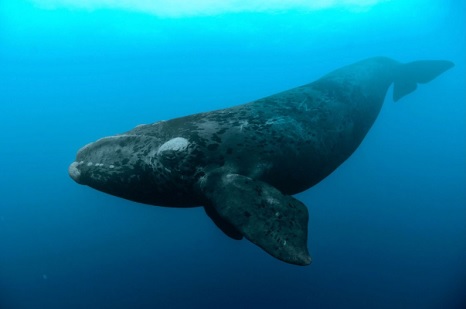
OFFSHORE WIND AND WHALES – A collection of articles from fisherynation.com By Jim Lovgren
After over forty-five years as a commercial fisherman out of Point Pleasant NJ, I sold my boat the Shadowfax, and retired, moving to California. My experience as a fisherman began in the early 1970’s, and I observed and learned an encyclopedia of knowledge concerning fishing, the environment, and fishery management, including politics. As I observed the continuing massacre and the lies denying them by government and media puppets, I under took an effort to expose the truth concerning offshore wind. The following articles are listed in order of their appearance in Fisherynation.com, and are best understood by reading them in order. Just click on the title of an article you’d like to read. more, >>click to read<< 15:09
OFFSHORE WIND AND WHALES – A collection of articles from fisherynation.com By Jim Lovgren
 After over forty-five years as a commercial fisherman out of Point Pleasant NJ, I sold my boat the Shadowfax, and retired, moving to California. My experience as a fisherman began in the early 1970’s, and I observed and learned an encyclopedia of knowledge concerning fishing, the environment, and fishery management, including politics. As a younger fisherman I saw early on that two issues were most important to fishermen, the environment, and proper fishery management. To me, the environment was the most important, because if we destroy it, not only would fishermen be out of business, but many species could be wiped out. When I started fishing, New York and New Jersey treated the ocean as an open septic tank to cheaply dispose of their effluent, while burning barges, acid wastes and contaminated dredge spoils were routinely dumped in designated areas. It was so bad it led to the great fish kill of 1976. Thankfully over time, and much effort from an appalled citizenry, the destruction was stopped.
After over forty-five years as a commercial fisherman out of Point Pleasant NJ, I sold my boat the Shadowfax, and retired, moving to California. My experience as a fisherman began in the early 1970’s, and I observed and learned an encyclopedia of knowledge concerning fishing, the environment, and fishery management, including politics. As a younger fisherman I saw early on that two issues were most important to fishermen, the environment, and proper fishery management. To me, the environment was the most important, because if we destroy it, not only would fishermen be out of business, but many species could be wiped out. When I started fishing, New York and New Jersey treated the ocean as an open septic tank to cheaply dispose of their effluent, while burning barges, acid wastes and contaminated dredge spoils were routinely dumped in designated areas. It was so bad it led to the great fish kill of 1976. Thankfully over time, and much effort from an appalled citizenry, the destruction was stopped.
There was another problem facing the fishing industry in the early 1970’s that was even more devastating to the environment then the pollution taking place. This was the foreign factory trawler invasion that began in the 1950’s and virtually wiped out every major fish stock on the US and Canadian continental shelf. In 1976 the Magnuson Act was passed and it phased out foreign fishing vessels within the newly created EEZ, [Exclusive Economic Zone] the so-called two-hundred mile limit. The old Bureau of Commercial Fisheries was turned into the National Marine Fisheries Service that same year. Their major task was to rebuild our depleted fishery resources, while designing comprehensive management regimes for a large number of fisheries. A brave new world was created for fishermen that rapidly evolved into a race for bigger and better boats, while the NMFS was just starting to understand what it might take to rebuild certain stocks. This created fishing regulations that over time became more stringent as the initial regulations proved ineffective for many different reasons, including insufficient stock knowledge, fishermen non-compliance, and rapidly improving fishing technology and electronics.
It became clear to me that if fishermen didn’t become involved in the management of their livelihood, they would eventually lose it. Since none of the older fishermen at the Fisherman’s Dock Co- operative had time to engage in the BS involved in fishery management, I got involved, resulting in a lifetime of knowledge about the operations of the NMFS, BOEM, [formerly the Mineral Management Service] and the ACOE. Army Corps of Engineers. So if my commentary in some of the following Articles seem biased to any degree, Its because after a lifetime of dealing with these politically manipulated bureaucrats you become tainted by that contact.
After a lifetime of fishing I retired to write a book about it, which turned into another book,[ both of which are waiting to be completed] as one thing interrupted another. Early in 2023 as the toll of dead Whales started to rack up, I was appalled at the actual numbers involved. In all my years fishing and being an astute observer of the ocean environment, I never heard of so many marine mammal strandings in New Jersey. I knew this was coming because of my prior knowledge of the effects of
seismic air guns used by the oil industry, but never imagined that a government agency NOAA/NMFS that had been protecting our marine resources, would bow down to an out of control federal agency, [BOEM] that has more political clout than them. It appears that there have been multiple violations of the Marine Mammal Protection Act, Endangered Species Act, and National Environmental Policy Act by the Biden administration. These matters may remain in courts for years, and by that time it WILL be to late for the North Atlantic Right Whale.
As I observed the continuing massacre and the lies denying them by government and media puppets, I under took an effort to expose the truth concerning offshore wind. The following articles are listed in order of their appearance in Fisherynation, and are best understood by reading them in order. Just click on the title of an article you’d like to read. My thanks to Borehead and Carol, Fisherynation.com for being such ardent supporters of the fishing industry and the environment, and
allowing me the freedom to voice my opinion without being edited by any publication concerned about hurting someone’s feelings.
First article, is from January 2020, a comprehensive look at the future I hoped would never happen, and a harbinger of things to come.
“Offshore wind, What’s the big rush? >Part 1< and >Part 2<
The next articles are in succession, and are must read if you want to understand what is going on. On February 6, 2023, the series starts with an article questioning the integrity of the science and those using it.
“Are NOAA scientists being silenced?”
Next article continues the attack on the politically driven science that allows federal agencies to ignore reality. From2/26/23;
“NOAA and BOEM, ignorance is bliss”
The next article, from March 5, 2023 has sadly become true.
“The Whale Slaughter Continues, but is this just the beginning?”
From May 16, 2023, I point out the hypocrisy of the NRDC, by using their own words against them.
“NRDC announces state of emergency for Atlantic Whales”
On 6/7/23 I asked a very pertinent question;
“Is the great fish kill of 1976 about to be repeated?”
On 6/18/23 I exposed the most overlooked aspect of offshore wind;
“Offshore wind electrical substations, the secret, silent killers”.
To me, the next article from 6/25/23 is the most important article of the series, it exposes the truth behind what has been going on, and who has been manipulating who. Kind of destroys the who is funding who argument used by the NGO’s in regard to offshore wind opposition.
“Oil industry con game exposed, the old switcheroo”.
After reading a report from a Rutgers study documenting a hypoxic event had taken place during the summer of 2023 off the New Jersey coast, I wrote on 2/2/24;
“New Rutgers study confirms hypoxic event last summer off the New Jersey coast”.
The latest article from 4/9/24 deals with the results of a new study documenting that the noise created by Piledriving of wind turbine stanchions exceeds the stated levels approved by NOAA and BOEM.
“NOAA/NMFS ignores dangerous sound levels from piledriving”.
I wrote these articles because after a lifetime of living on the sea, you become one with it and its creatures, hopefully some people will take the time to understand exactly what is happening and why. Dive deep, because knowledge is power. “Fish On”. Jim
NOAA/NMFS Ignores Dangerous Sound Levels from Pile Driving – By Jim Lovgren
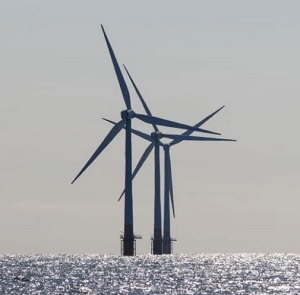 A new recently released report from Rand Acoustics, LLC scientifically documented that the stated sound levels created by the pile driving of wind turbine stanchions into the seafloor is much louder than the NOAA approved levels. In a study dated November 2, 2023, the researchers used acoustic listening devises to record the underwater sounds being created from piledriving by the crane ship “Orion” in the Vineyard wind BOEM lease area OCS-A 0501 southwest of Nantucket Island. Prior to this research, Rand Acoustics documented the underwater sound levels being produced by some of the research vessels using sonar and seismic devises to examine and document the seafloor prior to turbine construction. This research proved that the sound levels produced by these research vessels exceeded the stated sound levels approved by NOAA/NMFS to protect marine mammals and resulted in the documentary film “Thrown to the wind”. more, >>click to read<< 11:28
A new recently released report from Rand Acoustics, LLC scientifically documented that the stated sound levels created by the pile driving of wind turbine stanchions into the seafloor is much louder than the NOAA approved levels. In a study dated November 2, 2023, the researchers used acoustic listening devises to record the underwater sounds being created from piledriving by the crane ship “Orion” in the Vineyard wind BOEM lease area OCS-A 0501 southwest of Nantucket Island. Prior to this research, Rand Acoustics documented the underwater sound levels being produced by some of the research vessels using sonar and seismic devises to examine and document the seafloor prior to turbine construction. This research proved that the sound levels produced by these research vessels exceeded the stated sound levels approved by NOAA/NMFS to protect marine mammals and resulted in the documentary film “Thrown to the wind”. more, >>click to read<< 11:28
NOAA/NMFS Ignores Dangerous Sound Levels from Pile Driving – By Jim Lovgren
 A new recently released report from Rand Acoustics, LLC scientifically documented that the stated sound levels created by the pile driving of wind turbine stanchions into the seafloor is much louder than the NOAA approved levels. In a study dated November 2, 2023, the researchers used acoustic listening devises to record the underwater sounds being created from piledriving by the crane ship “Orion” in the Vineyard wind BOEM lease area OCS-A 0501 southwest of Nantucket Island. Prior to this research, Rand Acoustics documented the underwater sound levels being produced by some of the research vessels using sonar and seismic devises to examine and document the seafloor prior to turbine construction. This research proved that the sound levels produced by these research vessels exceeded the stated sound levels approved by NOAA/NMFS to protect marine mammals and resulted in the documentary film “Thrown to the wind”.
A new recently released report from Rand Acoustics, LLC scientifically documented that the stated sound levels created by the pile driving of wind turbine stanchions into the seafloor is much louder than the NOAA approved levels. In a study dated November 2, 2023, the researchers used acoustic listening devises to record the underwater sounds being created from piledriving by the crane ship “Orion” in the Vineyard wind BOEM lease area OCS-A 0501 southwest of Nantucket Island. Prior to this research, Rand Acoustics documented the underwater sound levels being produced by some of the research vessels using sonar and seismic devises to examine and document the seafloor prior to turbine construction. This research proved that the sound levels produced by these research vessels exceeded the stated sound levels approved by NOAA/NMFS to protect marine mammals and resulted in the documentary film “Thrown to the wind”.
From December 2022 to the present day, there have been over one hundred dead Whales of various species discovered either washed up on east coast beaches or floating offshore, including at least six critically endangered Northern Right Whales. An even larger number of Dolphins have also died mysteriously during this time frame which NMFS calls an UME [unexplained mortality event]. These abnormally high numbers of dead marine mammals have one thing in common, they die while offshore wind research vessels were blasting away nearby, or piledriving was taking place. This coincidence of dead marine animals washing ashore while Wind vessels were working nearby has been collaborated by using AIS marine tracking data of those vessels and the location of the dead marine mammals. While a paper has not yet been published, those results are known, and the study continues as the slaughter shows no signs of abatement. The killing isn’t just limited to Whales and Dolphins, it is all inclusive, Sharks, Sturgeons, Crabs, Clams, Turtles, and more have washed up dead at an alarming rate. But not alarming enough to concern the people in charge at NOAA/NMFS.
NOAA and BOEM are the two agencies’ responsible for issuing Incidental take permits to entities that may negatively impact upon a marine mammal’s health and environment. For many years the commercial fishing industry has been granted incidental take permits under strict rules of obedience, with many measures developed to reduce mortality. This has cost the fishing industry millions of dollars of lost revenue, but it has been beneficial in reducing gear entanglements and other sources of mortality to the threatened and endangered species they are designed to protect. Noncompliance of the regulations can result in catastrophic fines that can bankrupt the offender. NOAA/NMFS has been protecting marine mammals for decades from avoidable mortality by the fishing industry but stand by helplessly when Big Bad BOEM [BBB] allows unthinkable numbers of marine mammals to be harassed and killed by their patrons in the oil/wind industry. Over a decade ago BBB proposed allowing the level B harassment of over 13.5 million Whales and Dolphins over an eight-year period. That included an allowed 138,000 level A takes, [which is death] including 10 Northern Right Whales. Not surprisingly they met with strong opposition from virtually every environmental group in existence, and the proposal was dead on arrival. Now 10 years later those same research vessels have been giving the green light to do the exact same research that was turned down years earlier. The only difference is that the original proposal was for oil exploration, while the ongoing research is for wind turbines. Interestingly, most of the environmental groups that opposed the original BOEM oil exploration and its devastating consequences, are standing on the sidelines watching as what they once vehemently opposed, is now taking place, just under a different pretext.
These are some of the results from the newest Rand Acoustics LLC study that was conducted, titled, Technical Report: Pile driving Noise Survey, November 2, 2023. From the report, “The pile driving operations included double bubble curtains and hydro damper net for noise controls” These are two different noise mitigation techniques that are ineffective at anything except placating the public to believe that the noise being emitted is being reduced to harmless levels. “Nonetheless, the survey results find pile driving impulsive sound levels are similar to seismic air gun arrays and raise concerns about heightened adverse noise impacts on marine mammals”. The noise level of piledriving equaling that of air gun arrays is not a surprise, the fact that these high levels are reached despite the “best” efforts of Bubble curtains, and hydro damper net to reduce the noise, prove that those mitigation techniques are ineffective at best.
“The standard 90-percent RMS metric utilized by the NMFS underestimates the sound level experienced by cetaceans by as much as 6 dB, potentially cutting the protective distances in half and reducing marine mammal safeguarding zones by up to 75%”. This is a highly technical document, and very detailed in its exploration of the facts, but what was found in this report along with the prior report on sonar research, is that NMFS has consistently underestimated the noise level being produced by offshore wind operations.
“The continuous noise generated by vessel propulsion and dynamic positioning thrusters significantly surpassed the federal threshold for behavioral harassment, with noise levels exceeding 120 dB out to over 6 kilometers. Given federal agencies concerns over the compound effects of continuous and impulse noise, this frequently overlooked issue in regulatory assessments constitutes a definitive risk of behavioral harassment to marine mammals, underscoring the need to reevaluate “current
protective measures”. Surprise, just the operational noise of the piledriving vessel [not including the actual piledriving] is loud enough to constitute a behavioral response from marine mammals. This operational noise, although low compared to the effects of sonar, seismic, and piledriving, is a constant disruptive sound that is produced 24 hours a day for as long as the vessel is on site.
“NMFS anticipates that impacts to marine mammals would be in the form of behavioral harassment and no take by injury, serious injury, or mortality is proposed. The basis for the take estimate is the number of marine mammals that would be exposed to sound levels in excess of NMFS level B harassment criteria for impulsive noise [160dB re 1 uPa] and continuous noise [120 dB re 1 uPa rms]]”.
In conclusion; “This investigation discovered a substantial underestimation of both impulsive and continuous noise levels by current regulatory standards, suggesting that the actual exposure to harmful noise levels from piledriving for marine mammals like the critically endangered North Atlantic Right Whale is substantially greater than NMFS acknowledges in its existing protective measures. This indicates an urgent need to review and possibly revise NMFS monitoring protocols and mitigation.
strategies for pile driving to ensure adequate protection for marine mammals against both impulse and continuous underwater noise pollution. The findings detailed in this report underscore the need for immediate action due to the substantial underestimations uncovered by this independent investigation”.
These two studies by Rand Acoustics LLC. raise many questions. Top among them is why isn’t NOAA/NMFS aware of the underestimations of the noise produced by piledriving, sonar/seismic exploration, and even the excessive noise produced by the crane vessel during operations? There is supposed to be acoustic monitoring of these vessels during their operations, this is part of the mitigation protocols, is it being done? If so, where is the information? In regard to acoustic monitoring, there is an extensive network of listening devises operated throughout the Atlantic seaboard by the military, NOAA/NMFS and scientific institutions, what are they recording and is this being hidden from the public? This is important because low frequency noise can travel hundreds of miles underwater, meaning that a sound produced off of Nantucket may be heard off of Virginia. When you consider the amount of newly introduced noise into the environment in the last two years, from dozens of wind
related entities, its hard to imagine that the cumulative effects of such a multitude of noise sources would have no effect on marine mammals.
Is NOAA/NMFS going to review these findings, and using the new higher levels of sound documented, run new models to see if the actual sounds produced would result in a change from level B harassment to level A harassment? It’s pretty clear that something is killing the marine mammals on the east coast, and the only thing that is certain according to NMFS is that the deaths are not related to offshore wind activity. The results from the Rand investigations should change their minds.
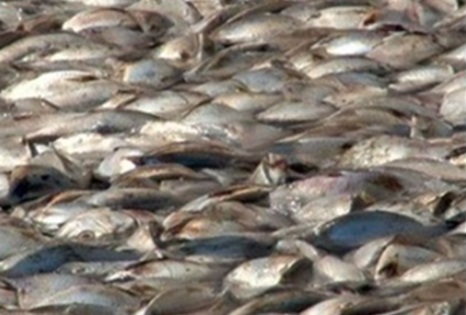
New Rutgers Study Confirms Hypoxic Event Last Summer off the New Jersey Coast by Jim Lovgren
In a scientific report released in December 2023 by Associate Professor Grace Saba, and Professor Josh Kohut using underwater robots, called “Gliders” to track ocean water quality, specifically, oxygen concentrations and PH levels, the researchers discovered that large areas of the New York Bight suffered a hypoxic event last summer. The study suggests that any of a number of factors could have caused these conditions, including a change in normal ocean stratification, increased input of nutrients which increase phytoplankton production, increased sea temperatures, and a few more. Conveniently missing from the possible causes of this hypoxic event is the impact of the offshore wind research vessels that have been extensively using high powered sonar and seismic devises throughout the New York bight area for over a year now. Also ignored was any outreach to the scallop fishermen along the coast who have been reporting unusual amounts of “clappers”, which are dead scallops, in their tows. In an article posted in the spring of 2023 in Fisherynation.com, “Is the Great Fishkill of 1976 About to be Repeated?“, I suggested that the New York bight could see an environmental catastrophe that could rival or surpass the great fish kill of 1976 and would be caused by the decomposing bodies of the dead sea creatures killed by the seismic and Sonar assault on the ocean bottom by offshore wind research vessels. Links, more, >>click to read<< 19:46
NEW RUTGERS STUDY CONFIRMS HYPOXIC EVENT LAST SUMMER OFF THE NEW JERSEY COAST BY JIM LOVGREN
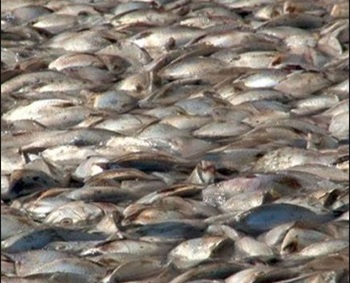 In a scientific report released in December 2023 by Associate Professor Grace Saba, and Professor Josh Kohut using underwater robots, called “Gliders” to track ocean water quality, specifically, oxygen concentrations and PH levels, the researchers discovered that large areas of the New York Bight suffered a hypoxic event last summer. The research used three different Gliders, with one of them tracking inshore waters from Long Branch to Cape May, out to about fifteen miles offshore, while the other two gliders worked together, and tracked down the southern edge of the mud hole out to about 30 fathoms where they then followed that depth in a southerly direction working 20 to 40 miles offshore.
In a scientific report released in December 2023 by Associate Professor Grace Saba, and Professor Josh Kohut using underwater robots, called “Gliders” to track ocean water quality, specifically, oxygen concentrations and PH levels, the researchers discovered that large areas of the New York Bight suffered a hypoxic event last summer. The research used three different Gliders, with one of them tracking inshore waters from Long Branch to Cape May, out to about fifteen miles offshore, while the other two gliders worked together, and tracked down the southern edge of the mud hole out to about 30 fathoms where they then followed that depth in a southerly direction working 20 to 40 miles offshore.
From their study; “Coast wide, hypoxic levels of dissolved oxygen [concentrations less then 3 mg/liter] were observed at shallower, more inshore locations. In addition to low ph measured in bottom waters, which is indicative of acidification, aragonite saturation state [a relevant metric for biological impacts of ocean acidification] was calculated to be less than one in several locations. Normal, more optimal levels in seawater typically include dissolved oxygen concentrations greater then 7 mg/liter,ph of 8.1 and aragonite saturation states greater than 3.” Glider #28 which tracked the inshore course, found hypoxic levels along its whole route, while gliders 39 and 40 found low aragonite levels at multiple locations along their offshore course. The researchers also were informed by fishermen of dead sea creatures being caught in their lobster pots along the mud hole, and also reports of more dead sea life off the near shore waters of southern Monmouth County, both areas of extensive offshore wind sonar and seismic testing.
From their study, “Mortalities were reported of American lobster, Jonah crab, Atlantic rock crab, spider crabs, Black Sea Bass, and tautog were reported not only in pots where trapped organisms would not have been able to escape poor conditions, but also on the open bottom. This observation suggests that if low dissolved oxygen and /or ph were indeed the culprit for these reported mortalities, the area may have been extensive enough that they could not escape in time.” The study suggests that any of a number of factors could have caused these conditions, including a change in normal ocean stratification, increased input of nutrients which increase phytoplankton production, increased sea temperatures, and a few more. Conveniently missing from the possible causes of this hypoxic event is the impact of the
offshore wind research vessels that have been extensively using high powered sonar and seismic devises throughout the New York bight area for over a year now. Also ignored was any outreach to the scallop fishermen along the coast who have been reporting unusual amounts of “clappers”, which are dead scallops, in their tows.
In an article posted in the spring of 2023 in Fisherynation.com, “Is the Great Fishkill of 1976 About to be Repeated?“, I suggested that the New York bight could see an environmental catastrophe that could rival or surpass the great fish kill of 1976 and would be caused by the decomposing bodies of the dead sea creatures killed by the seismic and Sonar assault on the ocean bottom by offshore wind research vessels. Throughout this past year, numerous accounts of dead sea creatures washing up on the beaches of Nantucket, and New Jersey have been reported, all of them while offshore wind vessels were surveying nearby. The dead marine mammals are well known casualties to the public, but authorities deny any connections between offshore wind and the strandings, while they refuse, even when perfect opportunities present themselves, to perform inner ear autopsies on these creatures that might discover the true cause of death. Likewise for years NOAA and BOEM have refused to perform any studies concerning the effects of loud sonar and seismic on marine mammals, leaving that to the US Navy, which was forced to by lawsuits. As a former member of the Mid Atlantic Fishery Management Council, I heard a term used by many fishermen in regard to NOAA/NMFS science, “Garbage in, garbage out.” This means if all information is not properly presented or not even included in a study, the result is useless garbage, usually to conform to a desired result. This Rutgers study, at this point, is very near to being in that category, because one of the most probable causes of this hypoxic event has been ignored and not even considered.
The great fish kill of 1976 may not ever been known about without the efforts of the commercial fishermen who observed the dying clams and other benthic organisms coming up in their dredges while working their historic fishing grounds and brought it to the attention of the authorities. That kill was caused by the continued use of the ocean as a cesspool for human excrement and environmental conditions that caused a large algae bloom and ultimately a large area of hypoxic ocean. Today, thanks to government [mis] management there are very few commercial fishermen left to report such conditions. The observations of scallop fishermen and the alarming amount of dead scallops they see in formerly healthy fishing grounds, that had recently been pounded by offshore wind vessels, has been ignored. Rutgers out reach to them has been nonexistent, yet a simple telephone call to any of the docks in New Jersey could have resulted in many more reports of dead sea creatures throughout the bight area. So this study is garbage by omission, with what appears to be an effort to blame the hypoxic event on global warming. Myself, I think that the conditions I cited in the Fisherynation article, water temperature in the 80’s, and a lack of storms to mix the water column during the tranquil summer months were not met. There could be many causes for last summer’s hypoxic event, but what is probably the real cause has not even been considered.
All is not lost though, this is an ongoing study, that hopefully will be performed each year, because the data that is gathered is very important in understanding what is happening in our ocean waters. Professor Saba is seeking information from anyone who has observed unusual sea creature mortalities over the past summer and can be contacted at [email protected]. I urge all fishermen, and citizens to report what they have observed this past year to her. Perhaps one of her students will take it upon themselves to research those studies from Australia that I cite in the fish kill article from last spring. Without such information this study becomes just another in a long line of advocacy science that has been produced in the last two decades.
The Rutgers report can be found on the Rutgers website https//www.rutgers.edu in the Department of marine and coastal sciences department.
Jim Lovgren: Walking with the Whales at Black Sands Beach, Shelter Cove, Ca.
Jim Lovgren 10/27/23
I was a commercial fisherman for over 45 years on the east coast and have seen hundreds of whales at sea, but there is nothing like seeing a large whale purposely swimming in the surf, while you’re standing thirty feet away. In Shelter Cove, a small fishing town of 700 residents in Northern California, Whales swimming in the surf, is a common occurrence during their spring and fall migrations and right now it is at its peak. My wife and I live just down the street from the famous Black Sands Beach where these Whales dare to get so close to shore and in the last 10 out of 12 days that we have looked we have observed the Whales in the surf.
Shelter Cove is remote and only assessable by one infamous road, but the drive is worth it, as most of the area is conservation land or wilderness. A small fleet of fishing boats operate out of there, but the port is limited to mostly smaller vessels, [less the 30 feet] since they must be pulled daily as anchorage is not safe. They’ve been struggling this year after the shutdown of the Salmon fishery and short Dungeness crab season, but the last couple weeks have seen 150 to 200 pound Bluefin Tuna brought home every day. They’re still there, within ten miles of the beach right now, check into a charter while you can. Along with the Tuna are migrating Humpback and Grey Whales whose spouts can be seen from the Cape Mendocino lighthouse park overlooking the Pacific Ocean, or a number of other parks along Pacific Drive. The real spot though is Black Sands Beach, at the northern most part of Shelter Cove, and the beginning of the famous Lost Coast Trail. Here those migrating Humpback and Grey Whales come to “scratch their backs” along the steep, rocky coast, in the surf. That surf is violent, as the shore drops precipitately just feet from the water line, and the waves are stood up as they hit the wall of the shore. The undertow is fierce, causing many warning signs placed along the pathway down to the beach including this; “Stay out of the ocean, not even your toes, Deadly and unexpected waves”. “Not even your toes”, that says it all about the conditions of the beach. Black Sands Beach is a misnomer, the “sand”, is actually surf rounded pebbles and smaller rocks one to four inches, with some larger ones mixed in. This rounding of the rocks enables dunes to shift size and locations along the beach rapidly, especially during storms, but what makes them dangerous is at the surf line, where they can suck in your feet and drag you in as they just slip under your flailing feet and the undertow grabs you. So don’t go near the water.
Yesterday my wife Cindy and I went down the road to the beach and pulled into the parking lot for Black Sands Beach and parked. Walking towards the northern overlook, that sits 200 hundred feet higher than the beach, I spotted a Whale as soon as I could see the beach, its two fins sticking out of the water like two sharks swimming in line, it was heading north. This unusual view of the Whales pectoral fin and one side of its tail happens when the Whale is swimming on its side, rubbing either its belly or back along the shoreline. We watched it as it turned offshore and around to the south. Having been observing local Whale’s behavior, we knew that it was going to stay around to get both sides scratched. We hurried down to the beach where we were able to get close enough to get some good video of the Whale. The Whale swam south towards us, in the surf, and about one hundred yards past the huge rock at the entrance to the beach, he did as I expected, and turned back around to the north. He then continued swimming to the north, in the surf, but about ten feet farther off then previously, soon leaving us tired out trying to keep up. We had enough exercise at that point and climbed back up the path to the parking lot. One last look north up the beach showed no sign of our friendly Whale, but
another Whale showed up in the surf, right in front of us. Ho-hum.
Today as I went down to take a picture of the beach for this article, sure enough a large whale was spouting about 400 feet north of me along the edge. I didn’t pursue it, but I believe this was a Gray whale, as it didn’t show much of its back when it spouted. The seemingly more common Humpback Whales generally expose a portion of its back when they surface to spout, and many times you can see the barnacles on their backs when they surface. Its these barnacles and the unique geologic
characteristics of Black Sands Beach that draw the Whales so close to the shoreline here. When they are in the surf, swimming, or just laying there hardly moving, they are letting mother nature scratch the barnacles off of them. Due to the sharp, steep shoreline, the Whales can rest safely along the ocean bank and their enormous body moves up and down with each swell, with the rocks of Black Sands Beach scrapping off their unwanted traveling companions.
I’m amazed by how many times I’ve seen people on the beach with a Whale right in front of them and they are unaware of it. They are not easy to spot, and even when you do, they might not come up again. You have to have patience, and good eyesight helps. Black Sands beach is huge, it stretches along the northern coast as far as the eye can see and is over five hundred feet wide along its southern stretch. Many times, you will be the only person on it. The best way to search for a whale in the surf at Black Sands beach, is to first view from one of the two parking lot areas, each has its own viewing areas. From up there you get a more aerial view of the shoreline. Concentrate your viewing on the shoreline directly in front of those parking lots, that is where they have been doing most of their back scratching. I’m not sure if time of day is important, because we usually go after 4 pm, but early risers report seeing them in the morning. High or low tide hasn’t mattered lately, but the height of the
surf definitely affects any Whale sightings. If the waves are higher than six feet you probably won’t spot a Whale, the surf is too dangerous. Search for bird play along the shoreline, [birds circling near the water surface], its an indication of fish, and hungry Whales. If you see bird play, concentrate your efforts there for a few minutes, looking for shadows in the water, or unusual turbulence in the water itself. The most common sighting is a spout, if you see one, wait for the second spout so you know which way the Whale is traveling. Once sighted, walk towards it quietly, and observe. Hopefully you can see its fins or tail break the surface, on rare clear calm days the Whales body can be seen as a shadow.
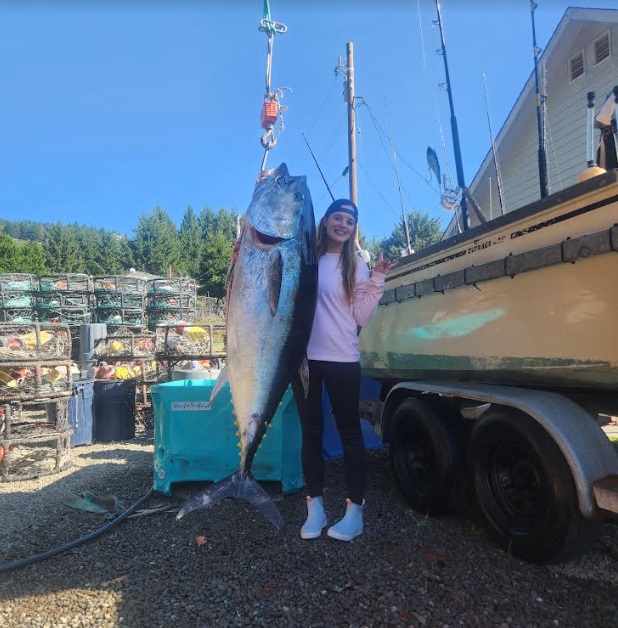
“Erica Herd with her 200 pound Bluefin Tuna recently caught on the “Whaler One” with Captain Johnathan Jeffers and Don Allred”.
Shelter Cove has its own Airport, and a nine-hole golf course where its easy to score a Vole in one. There are nice hotels and air B&Bs to stay overnight/s, and a number of fine dining restaurants to eat at. Shelter Cove has a diverse fishing fleet and offers charters targeting many different species according to seasons and regulations. The town also has a thriving artist community, maybe you’ll fall in love with a painting, wood carving, or jewelry at one of their art galleries. Just don’t miss the unique opportunity to walk with the Whales, the migration is seasonal, spring and fall, but they are sighted year round.

OFFSHORE WIND OPPONENTS NEED A MASS PROTEST IN WASHINGTON DC – BY JIM LOVGREN
In 2010 and 2012 fishermen held two different successful protests in Washington DC with thousands of fishermen travelling from around the country to attend. Both commercial and recreational fishermen voiced their concerns regarding catch shares and Magnuson Act reauthorization, among the multitude of issues that threatened their livelihoods. Today, the fishing industry is facing a far worse enemy then fishery management, as thousands of square miles of their historic fishing grounds have been auctioned off to the highest bidder in order to make way for the wildlife killing machines called wind turbines. These auctions have been held by BOEM, the Bureau of Ocean Energy Management, a part of the Department of the Interior. They are charged with the selling or leasing of US natural resources in our offshore waters, and apparently, they have absolutely no regard for any wildlife that may exist within them, or any people who might derive a living from catching said wildlife. >click to read< 11:50
OFFSHORE WIND OPPONENTS NEED A MASS PROTEST IN WASHINGTON DC – BY JIM LOVGREN
 In 2010 and 2012 fishermen held two different successful protests in Washington DC with thousands of fishermen travelling from around the country to attend. Both commercial and recreational fishermen voiced their concerns regarding catch shares and Magnuson Act reauthorization, among the multitude of issues that threatened their livelihoods. During the Obama administration, Jane Lubchenco, a PEW fellow, oversaw a major shift in the way we manage our fishery resources by introducing “Catch Shares” a controversial form of individual transferable quota, that has destroyed the very fabric of the New England ground fisheries. Many fishermen were almost immediately put out of business by the passage of Groundfish Amendment 13, the rest have slowly gone out of business, with large, pocketed vultures scooping up their quota, ultimately resulting in a Dutch company, Blue Harvest, owning a large portion of not only Groundfish, but also Scallops. This outcome was predicted by many experienced fishermen, but their concerns were ignored, as the Obama administration plowed over any objectors. Lawsuits were filed, including one with me as lead plaintiff, but they all failed to stop this disaster to our industry.
In 2010 and 2012 fishermen held two different successful protests in Washington DC with thousands of fishermen travelling from around the country to attend. Both commercial and recreational fishermen voiced their concerns regarding catch shares and Magnuson Act reauthorization, among the multitude of issues that threatened their livelihoods. During the Obama administration, Jane Lubchenco, a PEW fellow, oversaw a major shift in the way we manage our fishery resources by introducing “Catch Shares” a controversial form of individual transferable quota, that has destroyed the very fabric of the New England ground fisheries. Many fishermen were almost immediately put out of business by the passage of Groundfish Amendment 13, the rest have slowly gone out of business, with large, pocketed vultures scooping up their quota, ultimately resulting in a Dutch company, Blue Harvest, owning a large portion of not only Groundfish, but also Scallops. This outcome was predicted by many experienced fishermen, but their concerns were ignored, as the Obama administration plowed over any objectors. Lawsuits were filed, including one with me as lead plaintiff, but they all failed to stop this disaster to our industry.
Today, the fishing industry is facing a far worse enemy then fishery management, as thousands of square miles of their historic fishing grounds have been auctioned off to the highest bidder in order to make way for the wildlife killing machines called wind turbines. These auctions have been held by BOEM, the Bureau of Ocean Energy Management, a part of the Department of the Interior. They are charged with the selling or leasing of US natural resources in our offshore waters, and apparently, they
have absolutely no regard for any wildlife that may exist within them, or any people who might derive a living from catching said wildlife. Before the Biden Administration, BOEM generally dealt with offshore leasing to oil companies for oil and gas reserves. Those companies employed research vessels using seismic air guns to locate oil reserves deep within the earth’s crust, making deadly sound waves of over 240 DBs, coincidentally in many places marine mammals would mysteriously strand themselves on beaches and die. Now, thanks to the green new deal, those research vessels have been blasting the east coast since last November, [about the time that Whales started washing up dead on the beaches], to map the sub seafloor for offshore wind turbines.
The fishing industry has been keenly aware of the disastrous fate that offshore wind poses not only to their existence, but also to the marine creatures who inhabit it. BOEM has run roughshod over not only the fishing industry, but the federal agency in charge of managing those fishery resources. Flexing their bureaucratic muscle, they have highjacked fishery management from the National Marine Fishery Service who has been relegated to an observer of the unfolding environmental disaster being created in order to save the world. The death of hundreds of marine mammals along the east coast, washing up on public beaches, finally awakened the public to the environmental dangers that offshore wind causes. Activist groups sprung up in opposition to offshore wind, and protests have been held regularly in many states. A petition circulated in New Jersey garnered over 500,000 signatures calling for a halt to sonar and seismic activities until an investigation into the strandings takes place. Multiple lawsuits have been filed and are working their way through various court districts. While these suits may eventually prevail, in the meantime construction and cataclysmic noise making continue. Every day that goes by more historic fishing grounds are lost as thousands of tons of large boulders are dumped onto the seafloor around turbine bases. These grounds will be unfishable to mobile gear for hundreds of years.
Now is the time for the American public to stand up and fight the corruption in our state and federal governments, a mass demonstration needs to be held in Washington DC as soon as possible, before the green new deal bankrupts our country, and destroys our ocean and its creatures. Northern European countries have the highest electric rates of any developed country in the world, excluding islands. Some of them are having serious doubts about their decision of closing down coal and nuclear plants for renewable energy sources that are not only more expensive, but totally unreliable. We can stop this, but it will require a lot of work, getting groups to work together to plan out details, getting permits, publicizing the protest, etc. Step one is to circulate this article among fishing and public groups opposed to offshore wind and generate a discussion among these groups and their leaders about organizing the protest. Wouldn’t it be amazing if those 500,000 people who signed that anti-wind petition showed up in Washington DC.? I think this amount of people is possible if properly publicized, and it would have an immediate effect. Although the east coast has been affected before the Gulf of Mexico, and the West coast, BOEM has plans for them too, so if fishermen value their livelihoods, no matter what coast they live on, they need to make plans and get involved.

Oil Company con game exposed; the old switcheroo by Jim Lovgren
Oil companies developed techniques to not only locate oil and gas reserves thousands of feet below the ocean bottom, but to drill and recover them. Unfortunately, the tools used to locate oil reserves under the ocean floor, primarily seismic air gun arrays, have left a trail of dead sea creatures in its wake. Just like the US Navy, who for years denied the growing body of evidence linking military sonar usage to localized marine mammal strandings, the oil industry has denied any link of seismic research to the marine mammal strandings that invariably occur near their operations. Along comes Biden’s green new deal, and the east coast is now swamped with offshore research vessels using both sonar and seismic devises to map the sea floor and thousands of feet underneath it, for wind development. The same vessels in many cases that would have been involved with the 2012 proposed marine mammal massacre in search of oil reserves. These vessels are not only surveying the area in the lease site, but for many miles away from them, in many cases overlapping into other lease sites, or just mapping bottom that will never be available. Why? >click to read< 11:11
Oil Company con game exposed; the old switcheroo by Jim Lovgren
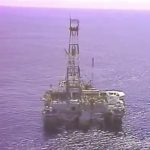 As the human population continues to increase in abundance, the need for natural resources to sustain our existence also increases. This places a demand on our environment to supply food, through Agriculture, Aquaculture, hunting and fishing, but also to supply natural resources such as fossil fuels, and minerals to support an increasingly urban population. For more than a century, fossil fuels have led humanity to unthinkable advances in transportation, electrical production, food production, virtually all of the advancements of the last century and a half have the use of fossil fuels to thank. The downside of this usage has been air pollution, destruction of all types of habitats by exploration, mining, and drilling. Over the last fifty years, as our easy to find land based natural resources have been depleted, man has looked at the resources that are not easily discovered or recovered, those on and under the ocean floor, including fossil fuels and minerals.
As the human population continues to increase in abundance, the need for natural resources to sustain our existence also increases. This places a demand on our environment to supply food, through Agriculture, Aquaculture, hunting and fishing, but also to supply natural resources such as fossil fuels, and minerals to support an increasingly urban population. For more than a century, fossil fuels have led humanity to unthinkable advances in transportation, electrical production, food production, virtually all of the advancements of the last century and a half have the use of fossil fuels to thank. The downside of this usage has been air pollution, destruction of all types of habitats by exploration, mining, and drilling. Over the last fifty years, as our easy to find land based natural resources have been depleted, man has looked at the resources that are not easily discovered or recovered, those on and under the ocean floor, including fossil fuels and minerals.
Oil companies developed techniques to not only locate oil and gas reserves thousands of feet below the ocean bottom, but to drill and recover them. Unfortunately, the tools used to locate oil reserves under the ocean floor, primarily seismic air gun arrays, have left a trail of dead sea creatures in its wake. Just like the US Navy, who for years denied the growing body of evidence linking military sonar usage to localized marine mammal strandings, the oil industry has denied any link of seismic research to the marine mammal strandings that invariably occur near their operations. To their credit, newer seismic and sonar equipment has been created that is less intrusive, [to a degree] to the marine environment. Seismic air gun arrays typically operate in the 240-245 DBs sound level, while newer sub-bottom profilers typically operate in the 200 to 210 DBs range, but can reach over 230 DBs depending on the power level used. Underwater sound over 180 DBs is recognized as being harmful to marine
mammals, and can cause TTS, Temporary Threshold Shift, or at louder levels PTS, Permanent Threshold Shift, which results in death. When the US government, through NOAA or the Department of the Interior issue Incidental take permits, they are classified as level B, which can cause TTS, or Level A which can cause PTS.
The exploration and drilling for oil and mineral deposits in the ocean has crept into depths of water unimaginable only a few decades ago, causing unknown effects upon the marine environment and the creatures that inhabit it. Because these effects are not visible, being under vast amounts of surface water, it is hard to know if harm is being done by these efforts, unless a situation such as the BP gulf oil spill takes place, and oil rises to the surface. Just as the Exxon Valdez disaster two decades
before, awakened the public to the hazards of oil tankers with single hull designs, prone to puncture, the BP disaster spotlighted what happens when a deep water well has a catastrophic failure. With increasing public awareness of “climate change”, which was “Global Warming” before that, and even the coming “Ice age” only 40 years ago, fingers pointed to fossil fuels as the cause of these effects. This has led to an increased development and usage of “green Energy”, primarily Solar, and Wind, while painting fossil fuels as the villain of all that is wrong in the world. This is poetic justice as it was the oil companies that created Oceana over two decades ago to villainize the commercial fishing industry to cover up their own sins.
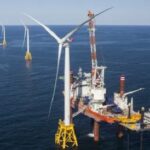 A few decades ago, the huge American tobacco companies faced a serious problem as lawsuits and an awakened population fought to limit or ban altogether the use of tobacco products due to their now known deleterious health effects. This forced the companies to diversify into other business areas, or go bankrupt. We see the same thing happening now with our fossil fuel producers, they can see the writing on the wall as public opinion has shifted against them due to fears of climate change. While US based oil companies have been slow to invest in renewable technology, European companies have not. Orsted, a multinational power company based in Denmark, has purchased the most wind lease areas on the US east coast. TotalEnergies is a French oil/power company, while Shell is Dutch, and Blackstone is Canadian. Interestingly these companies last year broke records in the amount of money paid for 5 leases in the New York bight last year, with bids reaching over 4 billion dollars, an average price of 800 million each. The unexpected bidding took everybody by surprise, as BOEM expected the sales to fetch around one billion total. Two months after that auction, two more lease areas were sold off of the North Carolina coast, one to TotalEnergies for 160 million, and the other to Duke Energy Renewables for 155million. This was followed by a December sale for six sites off of the California coast, that reaped 757 million total with winning bids ranging from 130 million, to 173.8 million.
A few decades ago, the huge American tobacco companies faced a serious problem as lawsuits and an awakened population fought to limit or ban altogether the use of tobacco products due to their now known deleterious health effects. This forced the companies to diversify into other business areas, or go bankrupt. We see the same thing happening now with our fossil fuel producers, they can see the writing on the wall as public opinion has shifted against them due to fears of climate change. While US based oil companies have been slow to invest in renewable technology, European companies have not. Orsted, a multinational power company based in Denmark, has purchased the most wind lease areas on the US east coast. TotalEnergies is a French oil/power company, while Shell is Dutch, and Blackstone is Canadian. Interestingly these companies last year broke records in the amount of money paid for 5 leases in the New York bight last year, with bids reaching over 4 billion dollars, an average price of 800 million each. The unexpected bidding took everybody by surprise, as BOEM expected the sales to fetch around one billion total. Two months after that auction, two more lease areas were sold off of the North Carolina coast, one to TotalEnergies for 160 million, and the other to Duke Energy Renewables for 155million. This was followed by a December sale for six sites off of the California coast, that reaped 757 million total with winning bids ranging from 130 million, to 173.8 million.
To put this in perspective, in 2015 two companies bid less than 2 million dollars for 343,833 acres off of New Jersey. In 2018 three companies bid 405 million total for 390,000 acres off of Massachusetts. It appears that the wind lease sites in general have increased in desirability in the last 8 years, and that the price is being inflated by the entrance of deep pocketed oil companies in to the renewable market. But that doesn’t explain the recent disparity between the last years sales in the New York bight, and those later sales off of North Carolina, and California. Is close proximity to the New York metropolitan area worth that much more than sites off of our most populous state, California? Perhaps there is a different reason for those bank-breaking sales in the New York bight. In the late 1970’s and early 1980’s the oil companies did some seismic testing and experimental well drilling off the US east coast, including on the Georges bank. Most of the wells came up dry, and oil and gas reserves
discovered were considered not economically feasible to produce. There were a number of wells though, that indicated large natural gas reserves, these were all situated in the New York bight, precisely where those outrageously priced lease sales are. The winning bidders were Shell/EDF Renewables, winning two leases, Blackstone, Totalenergies, and Orsted, won the others. Is it a coincidence that oil companies paid what amounts to four times more then the average wind energy lease site sold for? The Marcellus shale deposits extend into the Mid-Atlantic outer continental shelf, and this is what was discovered 40 years ago with those experimental wells.
The 1980’s saw the east coast public up in arms about pollution caused by sludge and contaminated dredge spoils dumping, and Congress pushed through a ban on oil drilling along the whole east coast. Since that time the oil companies have been scheming about how to get back the east coast so they can get those reserves. Over the decades since, advances in drilling technology and the use of fracking have made previously unprofitable oil and gas reserves now profitable and also areas that were
inaccessible, are now accessible. The east coast drilling ban was partially lifted and plans were made to have an 8-year geographic survey of the whole east coast continental shelf in 2012. The newly renamed Bureau of Ocean Energy was in charge of this effort. They had been named the Mineral Management Service, but an investigation into its operations had disclosed widespread corruption involving bribes, sex with oil company executives, and cocaine parties. The government did what any government would do under the circumstances, they slapped a couple of wrists, and just changed their name, but not the people or mindset within the agency. If you think what is happening now to the marine mammals off our coast, where BOEM/NOAA has issued over 100,000 level B takes, and 332 level A takes, you should
see what was proposed in 2012, all predicated on the use of seismic air gun arrays. Over an 8 year period level A takes allowed would be 138,612 marine mammals, and level B takes would have amounted to 13,586,251. Included in the level A takes would be up to two Northern Right Whales a year, up to ten over the eight-year period. Fortunately, this proposal was defeated before it could start, thanks to the organizing work of Clean Ocean Action, and also the now absent, NRDC, Environmental
Defense Fund, Conservation law Foundation, and many more who opposed seismic testing for oil exploration. With not only increasing energy demands, but also the need for rare earth minerals, the energy industry has been desperately seeking to map our offshore energy and mineral deposits for exploitation but have met too much opposition from environmentalists opposed to oil drilling.
 Along comes Biden’s green new deal, and the east coast is now swamped with offshore research vessels using both sonar and seismic devises to map the sea floor and thousands of feet underneath it, for wind development. The same vessels in many cases that would have been involved with the 2012 proposed marine mammal massacre in search of oil reserves. These vessels are not only surveying the area in the lease site, but for many miles away from them, in many cases overlapping into other lease sites, or just mapping bottom that will never be available. Why? It can’t be just to kill everything on the ocean bottom, or could it? In the last century the European countries massacred over 100 million of their own people in wars, so they obviously don’t have much regard for human life, let alone a few Dolphins and Whales. They lie that their offshore wind farms have not caused any marine mammal deaths, yet the UK has seen a doubling of marine mammal strandings since the year 2000, when they started building offshore wind factories. The mad rush to map the east coast as quickly as possible with as many vessels as they could procure is because they know their time is limited. It’s limited by how long it takes the American public to realize that they have been victimized by the old “switcheroo”. The oil
Along comes Biden’s green new deal, and the east coast is now swamped with offshore research vessels using both sonar and seismic devises to map the sea floor and thousands of feet underneath it, for wind development. The same vessels in many cases that would have been involved with the 2012 proposed marine mammal massacre in search of oil reserves. These vessels are not only surveying the area in the lease site, but for many miles away from them, in many cases overlapping into other lease sites, or just mapping bottom that will never be available. Why? It can’t be just to kill everything on the ocean bottom, or could it? In the last century the European countries massacred over 100 million of their own people in wars, so they obviously don’t have much regard for human life, let alone a few Dolphins and Whales. They lie that their offshore wind farms have not caused any marine mammal deaths, yet the UK has seen a doubling of marine mammal strandings since the year 2000, when they started building offshore wind factories. The mad rush to map the east coast as quickly as possible with as many vessels as they could procure is because they know their time is limited. It’s limited by how long it takes the American public to realize that they have been victimized by the old “switcheroo”. The oil
companies could not get seismic mapping of the east coast approved because of public opposition to oil drilling, so they are using another tactic, using climate fear mongering and the dream of a carbon free future thanks to the miracle of wind turbines. The oil companies have won this war, the marine environment has lost. As wind developers are increasingly delaying, or even cancelling projects due to escalating costs, and increasing public opposition, the oil companies will now, thanks to the intense bottom surveying, know where and how much oil and gas reserves are off the east coast. Mineral deposits are bound to be discovered, and the pressure will be brought to mine them. The industrialization of the Atlantic seaboard has just begun, aided by the so called environmental groups that had previously been opposed to such operations. Its amazing how a few dollars have the ability to influence an NGO’s integrity.
The Inflation Reduction Act places new restrictions on the Department of the Interior’s authority to issue offshore wind leases. For ten years after the enactment of the IRA, BOEM will be prohibited from issuing an offshore wind lease area under 43 U.S.C. 1337[p][1][c[, unless BOEM has offered at least 60 million acres on the outer continental shelf for oil and gas leasing, and also executed an oil and gas lease in that offshore lease sale in the previous year. BOEM has proven that it is still in the deep pockets of the oil industry, they’re just a little better at hiding it.
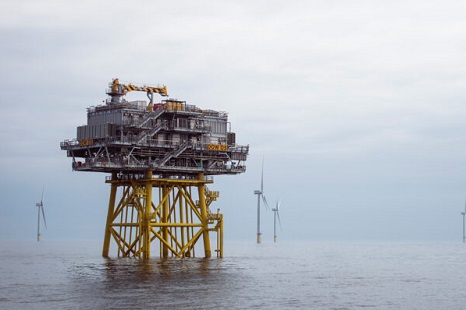
Offshore Wind Electrical Substations; The Secret, Silent Killers by Jim Lovgren
The marine mammal strandings that are taking place almost everyday along the US east coast are the most visible consequence of the Biden administration’s reckless disregard of all environmental safeguards that had been carefully crafted since the environmental movement started in the 1960’s. Embarrassingly, the cowards at the National Marine Fishery Service have stood by and watched as research vessels have been performing geologic surveys with high powered Sonar, and Seismic devises before they had their incidental take permits issued. They have also authorized over 100,000 level B takes of marine mammals, and that’s just for a few projects, as they fully expect the offshore wind factories to cause the extinction of the critically endangered Northern Right Whale. Just ask Sean Hayes, from the NMFS protected species department, whose observations were ignored by BOEM, hence an ESA violation. >click to read< 11:34
Offshore Wind Electrical Substations; The Secret, Silent Killers by Jim Lovgren
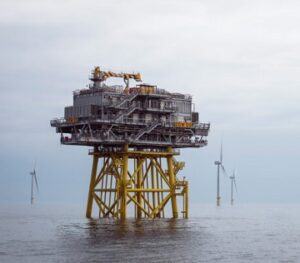 The marine mammal strandings that are taking place almost everyday along the US east coast are the most visible consequence of the Biden administration’s reckless disregard of all environmental safeguards that had been carefully crafted since the environmental movement started in the 1960’s. Left by the wayside in their rush to meet artificially imposed production deadlines, are the Clean Water Act, Endangered Species Act, [ESA] and the National Environmental Policy Act, [NEPA]. A rouge and abhorrent federal Agency, BOEM, [Bureau of Ocean Energy Management], under the Interior Department, has highjacked Fishery Management and protection of our marine resources from the National Marine Fishery Service, [part of NOAA, and under control of the Commerce Department] and has thumbed their nose at any restraints that are legally required under both the ESA and NEPA. Embarrassingly, the cowards at the National Marine Fishery Service have stood by and watched as
The marine mammal strandings that are taking place almost everyday along the US east coast are the most visible consequence of the Biden administration’s reckless disregard of all environmental safeguards that had been carefully crafted since the environmental movement started in the 1960’s. Left by the wayside in their rush to meet artificially imposed production deadlines, are the Clean Water Act, Endangered Species Act, [ESA] and the National Environmental Policy Act, [NEPA]. A rouge and abhorrent federal Agency, BOEM, [Bureau of Ocean Energy Management], under the Interior Department, has highjacked Fishery Management and protection of our marine resources from the National Marine Fishery Service, [part of NOAA, and under control of the Commerce Department] and has thumbed their nose at any restraints that are legally required under both the ESA and NEPA. Embarrassingly, the cowards at the National Marine Fishery Service have stood by and watched as
research vessels have been performing geologic surveys with high powered Sonar, and Seismic devises before they had their incidental take permits issued. They have also authorized over 100,000 level B takes of marine mammals, and that’s just for a few projects, as they fully expect the offshore wind factories to cause the extinction of the critically endangered Northern Right Whale. Just ask Sean Hayes, from the NMFS protected species department, whose observations were ignored by BOEM, hence an ESA violation.
Despite government and wind supporters denying any proof that could link the unseen before amount of strandings to the coincidental use of geological sonar and seismic research, [usually only of a type performed by oil companies] in the near vicinity of the strandings, the evidence mounts. This week, two Humpback Whales washed ashore in Martha’s Vineyard, coincidentally only a few days after Piledriving started at a nearby wind site. Piledriving of the turbine stanchions creates a 260 DBs level sound, that no amount of “Bubble Curtains” can contain. It is deadly. A few weeks before that beaches on the south shore of Nantucket had a carpet of dead crabs, clams, and other benthic organisms that are susceptible to seismic testing, which coincidentally was taking place nearby, [“sparkers” and sub- bottom profilers are seismic equipment]. The relationship of marine animal deaths while unsafe level industrial noises are being produced in the same vicinity are too numerous to ignore, worldwide. So, stop denying them.
Marine Noise pollution has been an increasing problem on an Oceanic level since the invention of the steam engine. Most of that noise increase was caused by increased vessel traffic, by increasingly larger ships, [and faster, so they could hit more Whales], but as the 20th century dawned, War became the largest noise increase ever. Torpedoes, depth charges, 16 inch shells exploding, and finally the creation of Sonar. There has never been an accounting of how many marine mammals died from the 20th century wars, but the amount would be staggering. Just as staggering would be the amount of marine mammals killed by the military, [that’s all countries] in training exercises, or testing of weapons, like at Bikini Atoll.
In the 1960’s as the Soviet factory fishing fleet was in the process of catching everything in the ocean as close as 12 miles off the US coast, our fisheries began to suffer from a silent deadly killer within, open cooling system nuclear power plants. By the mid 1970’s there were around 40 operational nuclear power plants on the US east coast all using estuarine or ocean water to cool the reactor system. How deadly are they? The following is from an NRDC issue brief, April 2014, “Power plant Cooling and Associated impacts”; “As water is being drawn into a cooling system, full-grown fish and other aquatic life are smashed and trapped against screens at the opening of an intake structure. This is referred to as impingement. In addition, early-life-stage fish, eggs, and larvae are often sucked into the cooling system, where they are harmed by heat, pressure, mechanical stress, and/or chemicals used to clean the cooling system before being dumped back into a water body. This is referred to as entrainment.”
Now it gets interesting, NRDC continues; “Throughout the country, the toll on fisheries by power plants rivals or even exceeds that of the fishing industry.
* The Salem Nuclear Plant in New Jersey kills an estimated 1.12 million weakfish and 842 million bay anchovies per year-four times more than are caught by commercial fishermen.”
* The 16 California power plants using once through cooling systems have the ability to suck in around 14.5 billion gallons of seawater every day. Annually they kill an estimated 2.4 million fish and 17.5 billion larvae. For the 12 coastal power plants in the Southern California Bight, impingement of recreational fish species accounts for 8 percent to 30 percent of the number of fish caught in the Bight.
* Cumulatively, the five power plants on New York’s Hudson River have killed as many as 79 percent of all the fish born in a single species in a single year.
* In 2008, the Bayshore coal power plant in Ohio killed more than 60 million adult fish and more than 2.5 billion fish eggs and larvae. Three of the plants four units shut down in September 2012, thereby reducing the number of fish kills since then; nevertheless, the EPA admitted that the plant likely impinged and entrained more fish than all of Ohio’s other cooling water intakes combined.”
There can be no scientific debate about the massive aquatic mortality caused by “Once-through” cooling systems that draw upon estuarine or ocean water for cooling purposes. That is why new power plants are now prohibited from using them. Apparently, nobody gave the folks at BOEM the memo. In an official BOEM document written by Pamela Middleton and Bethany Barnhart called, “Supporting National Environmental Policy Act Documentation for Offshore Wind Energy Development related to High Voltage Direct Current Cooling Systems” the authors contend that the only feasible cooling system for a HVDC Substation is a once through, or open system. The kind that is not allowed for new power plant construction, because of its devastating effects on aquatic life. This embarrassing Official BOEM document concerning the effects of offshore wind substations admits it knows nothing about how many substations are planned, how big, and where they will be. NEPA concerns such as environmental and economic costs to other industries are totally ignored within the enormous expanse of information contained within the 4 ½ pages of actual text. Up until the Green new deal a NEPA supporting document would be hundreds, and even thousands of pages long, detailing all aspects of a proposed project.
From page #1 of the BOEM NEPA document; “Converting high voltage electricity from AC to DC for long range bulk transmission from offshore wind farms reduces losses of power experienced on AC transmission lines and becomes cost effective within 37 to 60 miles from shore [BVGassociates, 2019;ICF, 2018]. When electricity is generated offshore, it is converted from AC to DC for transmission from the offshore windfarm, then converted back to AC onshore for distribution to consumers. The offshore conversion from AC to DC is accomplished through an HVDC system located in the wind farm. The HVDC system converts AC to DC, creating a byproduct of heat in the process. For the system to operate continually, the portion of the conversion equipment that emits heat, called the “thyristor,” must be cooled.” Keep in mind that this conversion process means that AC is converted to DC in an offshore substation, then DC is transmitted under the seabed to shore where it is converted back to an AC land-based substation. Which generates more heat into the atmosphere, and no mention is made of what cooling system will be used for the onshore substations, or where they will be located.
How big is a substation? From page 2, “Presently HVDC system structures for an offshore wind farm range from about 200 to 400 feet long, 140 to 350 feet wide, 80 to 300 feet high, and weigh several thousand tons [Mayflower Wind Energy, LLC, 2021; Sunrise Wind, LLC, 2021; Siemens, 2015; Kirchgeorg, et al, 2018] These structures are likely to get larger as offshore wind farms grow and move further offshore.” These structures are massive already, and may get bigger. What does that mean? How big is big? If an offshore site has 80 turbines how many substations are needed? One, two, ten? There is no mention in the document. How are they secured to the bottom? How many gallons of sea water would be circulated through a once through system per hour? How many degrees hotter would that dumped water be than it was before being used? What species of fish will be impinged and what is the economic effect on the fishing industry? None of these basic NEPA information requirements are included. Instead, we get this in regard to impingement and entrainment; “Most filtration systems backflush filters to allow for continuous use, so the collected filtrates will eventually return to the ecosystem; however, larval species will be lost and will not grow to maturity.” {Woke-speak for they will be killed]. “The number of larval fish and invertebrates lost in the process is difficult to measure. Losses of larval food sources for other species is notable, in addition to the larval species that do not survive to maturity. It is unclear how many marine species do not mature to reproduce and provide fish and shellfish for human and animal consumption.” They might as well have added, “and we don’t care.”
The whole point of these wind turbines is to stop Global warming, yet a new study from Harvard concluded that warming continental temperatures could ensue from widespread wind energy, primarilythrough enhancement of low-level atmospheric mixing and interruption of radiative nighttime cooling. This net localized effect was quantified in 10 other studies. In regard to the “warm” water discharged from an offshore substation, the BOEM document has this to say, “Temperatures of the discharge water have not been documented for the proposed wind farms on the OCS to date. The warmer outflow from HVDC is generally accepted as a minimal effect that will be absorbed and transition to ambient temperatures over time.” “Given the single point outlet within the large mass of surrounding ocean, effects from the warm water are likely to be extremely minimal. Similar conclusions have been made for any chemicals added to prevent growth within the seawater system.” Those chemicals include sodium hypochlorite, used to kill any tiny marine life that might dare to attempt to grow within the system, at least it is noted that sodium hypochlorite would be used in the 10-200 parts per million, but it doesn’t say per million of what, assumed to be ocean water. So, the water will be heated substantially but to an unknown degree, while at the same time an anti-lifeacide chemical will be introduced to the marine environment, but don’t worry the ocean can absorb it all. Just like the good old days.
I think this BOEM NEPA document perfectly presents the Biden regime’s contempt for the environmental laws that have been put in place over the last half century to protect our wildlife and environment. This paper has a disclaimer inside stating the views and conclusions contained in this document are those of the authors and should not be interpreted as representing the opinions or policies of the US government, nor does mention of trade names and commercial products constitute
endorsement or recommendation for use. BOEM should disclaim the whole document, pitiful as it is. I believe that this document was submitted in all its inadequacies on purpose to legally meet NEPA requirements concerning project submission timing, knowing that by the time any legal recourse could be taken, the issue would be moot. They are going full steam ahead and no stupid precautionary principle, or environmental law will stop them. The NRDC has provided us with the information proving how deadly “once through” cooling systems are, why are they even being proposed for usage? It is because they are cheaper, ignoring the environmental disaster they are creating, we must save the world. In reality though, it’s all about the Benjamin’s.
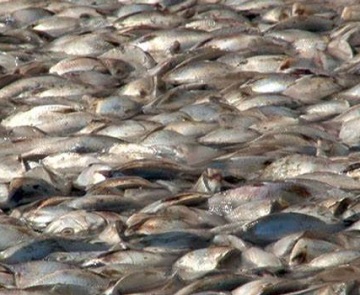
Is the Great Fishkill of 1976 About to be Repeated? By Jim Lovgren
In 1976 the United States suffered its largest man-made environmental disaster ever as 2,500 square miles of ocean died, thanks to a hundred years of sewage dumping by New York City and Northern New Jersey communities. This catastrophe awakened the public to this disgusting practice and environmental organizations sprung up to fight it, eventually winning the fight. Proving that the little guy can prevail against the “powers that be”. >click to read< 17:37
Is the Great Fishkill of 1976 About to be Repeated? By Jim Lovgren
 In 1976, our country suffered the worst man-made environmental catastrophe in its history up to that point in time. An estimated 2,500 square miles of ocean waters off the New York/ New Jersey coast experienced a Hypoxic event, [oxygen depletion], which began with a simple algae bloom offshore that drifted north into the sludge dump site 12 miles off Long Branch, N.J. When the bloom encountered the nutrient rich sewerage, it exploded in a feeding frenzy eventually expanding in size to cover from the south shore of Long Island down the Jersey coast as far as Atlantic city, and stretching 40 to 50 miles to the east. When the Algae started to die, [as it always does] it sank to the bottom and started to decompose, which results in oxygen depletion. Most of the fish in the area were able to swim away from the dead zone being created, but the bottom dwelling [benthic]species, clams, scallops, conch, starfish, crabs, and lobsters could not, and they died. The E.P.A. estimated kill ratios among bottom dwelling creatures in the dead zone at 40% to as high as 99.5 %.
In 1976, our country suffered the worst man-made environmental catastrophe in its history up to that point in time. An estimated 2,500 square miles of ocean waters off the New York/ New Jersey coast experienced a Hypoxic event, [oxygen depletion], which began with a simple algae bloom offshore that drifted north into the sludge dump site 12 miles off Long Branch, N.J. When the bloom encountered the nutrient rich sewerage, it exploded in a feeding frenzy eventually expanding in size to cover from the south shore of Long Island down the Jersey coast as far as Atlantic city, and stretching 40 to 50 miles to the east. When the Algae started to die, [as it always does] it sank to the bottom and started to decompose, which results in oxygen depletion. Most of the fish in the area were able to swim away from the dead zone being created, but the bottom dwelling [benthic]species, clams, scallops, conch, starfish, crabs, and lobsters could not, and they died. The E.P.A. estimated kill ratios among bottom dwelling creatures in the dead zone at 40% to as high as 99.5 %.
The Surf clam fishery off the Monmouth and Ocean County shore was devastated, and has been barely profitable since, except for use as bait. The nearshore scallop beds a few miles off Asbury Park, never came back. Lobsters reinhabited the mud hole over time, and the fall migration of finfish species occurred as usual. This Fishkill was a death blow for the New York and northern New Jersey sewer kings who did not want to clean up their act and insisted that the ocean can absorb it all. Commercial and recreational fishermen had been complaining about the water quality in the New York Bight for years by now, but nothing was ever done, as the government wanted to dispose of sewerage as cheaply as possible. After this unprecedented environmental disaster, they were forced to do something, as the general public was now up in arms, and environmental organizations were springing up with the express purpose of stopping Ocean sludge dumping. The American Littoral Society, created by Monmouth County resident Derry Bennet led the anti-sludge dumping movement, soon joined by the newly created Save our Shores. In 1983 Derry created Clean Ocean Action, and hired Cindy Zipf to run it. Eventually sludge dumping ended in 1989 by an act of Congress. This Fishkill also brought other barbaric dumping practices to the public’s attention, in particular Acid Dumping on the Cholera Banks, burning barges from the NY harbor, and contaminated dredge spoils. All of these fights were led by Clean Ocean Action, who successfully sued the NY/NJ Port Authority over contaminated dredge spoils dumping, which was loaded with P.C.B.s and Dioxin. Their lawsuit resulted in setting nation-wide standards for the amount of contaminants allowed in dredged material before it is not allowed to be dumped in an ocean dump site. The point of this is, citizens can unite and fight the bad guys, if they work together, and develop a strategy of attack. Unfortunately, it took an environmental disaster for the public to wake up and become involved.
That is where we are now, on the verge of a manmade, greed-driven, environmental catastrophe that will make the 1976 fish kill look like child’s play. This one involves animal extinctions. Many people are aware of the recent spate of marine mammal deaths along the east coast, but many do not, because the mainstream media is trying to ignore them. Of course, when it is covered, it’s a paid-off flunky, or integrity challenged scientist who states that the deaths have nothing to do with offshore wind. In 1976 sewerage sludge was the catalyst for a massive Fishkill that just happened to have the right environmental conditions to amplify its effects. The coming catastrophe will be caused by noise.
The constant, incessant, deafening crescendo of high-powered sonar, seismic, and piledriving, 24 hours a day, season after season, year after year is going to permanently alter the marine environment and increase global warming. Recent scientific studies have found that windfarms actually increase the atmospheric temperature in its vicinity by several degrees, while an unknown number of massive electrical substations will be situated on each lease site drawing sea water directly into its system to cool off the heat generated by electrical conversion. The cooling system of these substations is comparable to the ancient nuclear power plant cooling systems that destroyed wildlife along the east coast by impingement and heating of the estuarine waters that the system used. Each of these substations are going to increase the water temperature around them, perhaps substantially, but don’t worry, the ocean can absorb it. Just like the old days.
While the government flunkies and windmill developers all chant there is no proof the sonar or seismic is harming the marine mammals that are increasingly winding up dead on our beaches, they ignore the growing mountain of evidence that proves it does. The real question is what are acceptable levels of noise that will not cause harm to creatures that rely on hearing to survive. Funny thing, it seems that the alphabet environmental groups only care about seismic and sonar testing when it affects our countries national security or the oil industry. They all have been remarkably silent, as they watch their worst nightmare unfold before their eyes. Greenpeace made saving the whales their number one priority, yet today simply say, the Whales are not being killed by windmills. Here’s an interesting quote
from Surfrider Tasmania President, Ally King from 2022, “ It is absolutely ridiculous to be allowing international companies to blast our coastline, with no benefit for local communities, or regard to marine life. The onus should be on the proponent to prove no harm, and the precautionary principle should be implemented until that is the case.” Miss King was talking about seismic testing for oil in this case.
The crutch that the windmill supporters cling to, the fact that there is no scientific evidence linking the marine mammal strandings to sonar or seismic testing, is a testament to the power of the oil companies upon our government agencies. The US government has done nothing in the way of research into what are undeniably dangerous levels of sound upon the creatures that are subjected to it, because if the facts are known, seismic testing of all forms and levels would be banned. Sonar would be regulated to safe levels under controlled conditions. Fishermen around the world know what the effects of seismic research does to the fisheries they depend on, but their reports of barren fishing grounds for years after seismic testing is ignored and ridiculed. Here is an eyewitness account of the aftereffects of seismic testing on a local fishing ground, the Manasquan Ridge.
In 2016 I was Fluke fishing on the Manasquan ridge on my 75 foot trawler, the Shadowfax, along with my brother Denis, with his boat the Kailey Ann. We were working on a 500 pound a day trip limit, which we were catching in two to four hours of towing time. That summer, the Army Corps of Engineers performed seismic testing on a number of near shore sand lumps to see if they were of a suitable material for use in beach replenishment. One morning the Army Corps research vessel showed up and started blasting away, crisscrossing the whole area of the ridge for days. I forget how many, could have been a couple weeks even. Our fishing remanded the same that first day, but was substantially reduced by the next. By the third day, we could no longer catch any Fluke there, and had to find another spot, either Augies to the north, or the Island beach tow, two miles offshore, which were unaffected. We did not catch another Fluke on the ridge that year, and it always was a hot spot in the
fall. In the six years since, the Manasquan ridge has not produced any profitable amount of Fluke. The seismic testing killed everything on the bottom, sand eels, clams, worms, crabs, all the benthic creatures that support an ecosystem. For a number of years afterwards the ridge didn’t hold fish that might have stayed for a while if there was something to eat. Today the ridge is covered in mussels which moved up from the south, taking advantage of the void left by the exterminated benthic organisms. You think maybe Rutgers might have wanted to research the effects of seismic testing in such a small local area that would have been perfect for a long term study. But no, they were too busy in 2015 killing Whales with their own seismic research, which didn’t include any study of what effects their work did to the marine ecosystem off of central New Jersey.
Critical research was done in regard to the effects of seismic testing on scallops, after Australian and Tasmanian fishermen claimed the scallop beds they were fishing had been wiped out by seismic testing for oil. IMAS and Curtin University found that noise from seismic air guns significantly increases mortality in scallops. In 2010 a seismic survey in the Bass Straight killed entire Scallop beds, resulting in a 70 million dollar loss to the local fishing industry. If seismic and sonar noises can be so deadly, what happens to the dead bodies of the animals that are killed? I have been getting credible reports from scallop fisherman who are noticing an abnormal amount of “clappers” in their tows. A clapper is a scallop that has died and its shell is still together, unlike when they are shucked, and their shells are separated. The Scallop beds northeast of the mudhole and Hudson canyon will be where we will find out exactly how much they are killing. These grounds are healthy, the scallops do not have the blister disease found in southern scallops so there is no natural cause to blame if these beds die. The Scallop industry is the most valuable fishery on the east coast, contributing hundreds of millions of dollars annually to the local economy, if these beds die the financial repercussions throughout the industry will
be catastrophic.
We have Whales and Dolphins washing up on our beaches in a daily routine, now endangered Sturgeons are washing up, along with sharks of all sizes, while the offshore wind vessels continue their environmental onslaught along the whole east coast. I believe that by the end of this summer we could be witness to the biggest manmade environmental disaster of all time. If the right environmental conditions line up, a hypoxic event of unseen before dimensions will occur. Sonar and seismic testing kill almost everything on the bottom below the research vessel. There are dozens of these killers crisscrossing every square inch of the bottom between Cape May and Nantucket Island leaving dead organisms in their wake. What happens when a sea creature dies, it lays on the bottom and bacteria start eating it. Sometimes algae blooms can form from this decomposition, these eat up the oxygen in the water and cause oxygen deprivation, which starts to kill the nearby creatures who then decompose and eat up more oxygen, multiplying the hypoxic event. The trigger for this to happen will be environmental with the two key ingredients being a hot summer with warmer than usual water temperatures, and a lack of any substantial storms during July and August. The storms will be the key as they have the ability to mix the water column and “stir things up”, which will oxygenate the water. If warm water lays undisturbed in the New York bight this summer then we are in trouble. Ocean layer stratification could also play a deadly part, if a lot of rain flushes fresh water out of the NY harbor into the mud hole area. Fresh water will lay on top of salt water because it is lighter and this layering is called stratification. This can create a situation where the salt water is trapped by the fresh water and will
magnify a hypoxic event.
Why hasn’t this happened before, after all Europe has been doing this for years in their coastal waters, and despite fishermen’s claims of dead fishing grounds, there has not been a hypoxic event there, at least that I know of. The difference between them and us is water temperature, the waters of northern Europe are quite a bit colder than those of the US east coast, colder water slows down decomposition, and the currents through the English Channel provide a stirring of the bottom. There has
never in history been such a large number of deadly noise makers in the same place, and it looks like it will be a hot summer. I pray I’m wrong about this…..
Natural Resources Defense Council Announces STATE OF EMERGENCY for Atlantic Whales By Jim Lovgren
 The National Resources Defense Council [NRDC] in a press release has declared a state of emergency for Atlantic Whales. Here are some excerpts from a piece written by Francine Kershaw, NRDC’s leading east coast Marine mammal expert. “Something is happening off our Atlantic coast. Unprecedented numbers of great Whales are washing up dead on our shores.” After a paragraph noting the recent Whale strandings and the National Marine Fishery Service announcement of three different unusual mortality events {UME] in the past year, the release states, “The North Atlantic Right Whale has suffered serious losses since 2010. Scientists recently estimated that, at this rate of decline, they may become functionally extinct in less than twenty years, [meaning there would be no individuals capable of reproducing left in the population]. The loss of a young female therefore represents a particularly devastating blow.”
The National Resources Defense Council [NRDC] in a press release has declared a state of emergency for Atlantic Whales. Here are some excerpts from a piece written by Francine Kershaw, NRDC’s leading east coast Marine mammal expert. “Something is happening off our Atlantic coast. Unprecedented numbers of great Whales are washing up dead on our shores.” After a paragraph noting the recent Whale strandings and the National Marine Fishery Service announcement of three different unusual mortality events {UME] in the past year, the release states, “The North Atlantic Right Whale has suffered serious losses since 2010. Scientists recently estimated that, at this rate of decline, they may become functionally extinct in less than twenty years, [meaning there would be no individuals capable of reproducing left in the population]. The loss of a young female therefore represents a particularly devastating blow.”
The release then points to Ship strikes and fishing gear entanglements as the leading cause of marine mammal strandings, and that climate change has caused a change in the migratory paths of Whales closer to shore where they encounter more ship and fishing activity. From its operational playbook, NRDC then offers mitigation idea’s to help reduce the Mortality of said mammals. “What can be done to reduce these strandings? Whale habitat is shifting in a way that is heightening the conflict between these much-loved animals and the ways in which we use our ocean, possibly for the long term. We therefore need lasting and timely protections from the stressors that are causing the most harm, such as more expansive regulations to reduce vessel speeds and a concerted effort towards ropeless fishing technology. NRDC is actively working with other environmental groups to advocate for these improved protections. It is also essential to minimize other stressors facing our great Whales to give them the best possible chance of survival.”
Here is where it gets interesting; “To protect our Whales, we must stop seismic. We must stop drilling. And we must protect the marine mammal protection act. As part of its atrocious giveaway to oil companies, the Trump administration has proposed permitting five large scale seismic surveys that, if approved, would crisscross the Mid Atlantic and south east coasts, blasting every 10 to 12 seconds for months at a time, with noise as intense as dynamite. Impacts to many types of marine life would be severe. For our Atlantic Whales already struggling to survive, seismic blasting would drown out the sounds they rely on to survive over vast swaths of ocean, making it impossible to communicate with one another, to find food, to detect predators. The stress of all that noise could also have long lasting impacts on their health, making them less likely to be able to successfully rear young. The North Atlantic Right Whale, already teetering on the brink of extinction, simply will not be able to withstand this assault. And of course, seismic testing is simply the first step down a path towards oil drilling off our coasts, placing marine life and our coastal communities at serious risk.”
“It is also crucial for us to defend the Marine Mammal protection act [MMPA], the bipartisan bedrock legislation that has successfully protected our nations for over 45 years. The act requires that industry act in a manner that minimizes harm to marine mammals. It will come as no surprise that special interests in Congress are actively lobbying to gut the act.”
NRDC has been the leading opponent of military sonar usage, its lawsuits successfully targeted the loud noises produced by military grade Sonar and even forced the US Navy to admit to killing hundreds of dolphins and Whales. This press release which was dated February 23, 2018 was in response to the proposed use of seismic testing off the US East coast for oil exploration using seismic air gun arrays that operate in the 240 to 250 DBs range of underwater sound. Military Sonar typically operates in 230 to 240 DBs range. Marine creatures of any size, in the direct path and close proximity to a sound source of that level will die a horrible death. Since the NRDC has been such a vocal critic of, seismic testing, [and manmade oceanic noise in general] due to its fatal effects on marine creatures, one would think that the recent upsurge in Whale deaths this past year, coincidental with a bunch of survey vessels using seismic and sonar apparatuses to map the seabed for offshore wind sites in close proximity to the stranding site events would have NRDC up in arms. But apparently, they do not care. Could this be because of the generous gift of one hundred million dollars from Jeff Bozo’s, who is, just coincidentally, the biggest investor in wind-power in the US, if not the entire world?
Conflicts of interest arise everywhere you look, in concern to offshore wind projects on the east coast. Formerly conservative minded entities have blindly accepted millions of dollars of hush money to go along with the green mafia’s attempt to destroy the United States energy independence and force reliance on Chinese manufactured goods for the benefit of Wall street investors. Here are a few of the infamous Vichy collaborators that have taken money from offshore wind companies, Woods Hole Oceanographic institute, New England Aquarium, Mystic Aquarium, National Audubon Society, The Nature Conservancy, World Wildlife fund, etc. The Etc. is needed because the amount of bribery involved in this massive swindle of what will be tax payer owed debt is enormous and a threat to national security.
Over the last few decades the NRDC has successfully challenged the US Military in regard to sonar effects on marine organisms, while also challenging seismic activity related to oil exploration. Both of these issues have national security implications that require a more robust examination of the possible causes of the legal actions taken, and why they were taken. What’s NRDC’s excuse for ignoring the growing amount of dead Whale carcasses that keep washing up on east coast beaches, while the
same research vessels that would have been doing the seismic and sonar research for the oil companies are doing it for the wind factories? They will argue that the vessels are not using a seismic air gun array, and that there is no proof that the lower powered Sonar and Seismic, [Sparkers are seismic and can operate above 200 DBs noise level] have killed any marine mammals. This is the scoundrels crutch, they know it is near impossible to prove that sonar and seismic killed a particular animal, so they ignore the dead carcasses, and their previously accumulated mountain of evidence that they used against the US Navy, and continue to save the planet for the good of Wall Street, I mean mankind.
So, the most relevant question, to NRDC, NMFS and BOEM is this; Why has the NMFS issued over 63,000 incidental harassment authorizations for level B takes [with over 100,000 more pending] which also includes 332 level A takes, which is death, if the sonar and seismic research does no harm? If Sonar and seismic has not killed the Whales, then why do the wind factories need to have incidental take authorizations, [which are simply a government issued license to kill]? I want to see someone from NMFS explain this seeming contradiction about no evidence that the research has caused the deaths of the Whales, yet the agency feels compelled to issue incidental takes to these vessels. If they are not causing any harm, what are you issuing permits for? How are those 332 marine mammals going to die?
And yes, the level A takes include at least one Northern Right Whale, of which NRDC expresses its regret, despite its previous concern about the death of any Northern Right Whale. Can’t stop progress.
NRDC insists that we must protect the Marine Mammal Protection Act at all costs, yet the wind companies have been allowed to thumb their noses at its provisions aided all along by a complaint NMFS that now appears toothless after years of ripping the commercial fishing industry a new A-hole. Attention NMFS, there are, and have been research vessels performing sonar and seismic activity before they have been issued proper authorizations. But they already know this, they’re just busy trying to hide it. This is a clear breaking of the law but no one is doing anything about it. The wind research vessels would rather pay a fine for breaking the law then have to pause their work due to the enormous daily operating costs of such vessels that can reach over $500,000 per day. But they have not even been charged. Do you think this would be allowed if the vessels were working for oil exploration?
From NRDC’s Joel Reynolds paper, “Submarines, Sonar, and the death of Whales” he writes; “The endangered species act, {ESA] requires federal agencies to obtain an incidental take permit beforethey engage in an activity that may “take” any threatened marine mammal or an endangered species. These permits must be obtained through formal consultation with NMFS or the Fish and Wildlife Service and apply additionally to any adverse modification of critical habitat. Under NMFS regulations, formal consultation MUST be requested and reinitiated where an agency discovers unforeseen effects on any listed species or critical habitat.”
I don’t think its hard to argue that turning the waters off the US east coast into an enormous electric factory doesn’t constitute an adverse modification to critical habitat. Likewise, the recent stranding events [of unknown cause] should cause a reconsultation of the permits since unforeseen events on listed species have taken place. Repeatedly.
Reynolds goes on in his paper in regard to NEPA; “The National Environmental Policy Act, [NEPA] establishes mandatory procedures for objective disclosure and analysis of a project’s individual and cumulative environmental impacts, consideration of alternatives, and identification of feasible mitigation to ensure that the project will not needlessly or carelessly destroy or harm the affected environment or species. This act also applies extraterritorially when federal agencies are taking actions
with a significant environmental impact.” Here’s one ripe for a legal challenge. The NMFS and BOEMhave both ignored the cumulative effects of having thousands of huge wind turbines placed throughout the whole range of the US east coast. They have been issuing incidental take permits in a vacuum oneproject at a time, and never considering what the cumulative effects of all the noise, and construction will have on the effected species. This is an absolutely unforgivable dereliction of legally required investigative work and is definitely cause for a suit. If it was the oil companies getting away with this, NRDC would have had them in court in a minute. Here’s an idea, use some of Bozo’s 100 million dollars to sue NMFS over NEPA, while there are still a few Whales left alive.
One last issue that came from NRDC’s Naval lawsuits is the recognition that not even national defense is exempt from environmental rules and regulations, so any claim that the wind factories must be installed as quickly as possible to save the planet have no basis in fact.
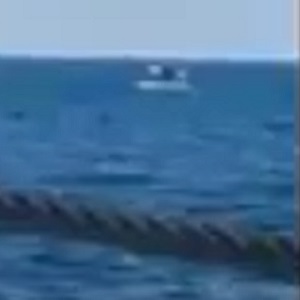
Distressed Whale spotted near offshore wind survey vessel – Jim Lovgren
Monday morning, March 20th, Bill Lovgren, the owner and Captain of the 72′ foot trawler, F/V Holdfast, left the Fisherman’s Dock Co-op shortly after 9 am for an offshore trip targeting Black Sea Bass and Summer Flounder with his two crewmen, James Lovgren, and Paul Kuchinski. Between them they have over seventy-five years of fishing experience from the port. This particular trip was unusual because the vessels fishing offshore generally leave port sometimes during the night due to having a 60- mile distance to travel to get to the grounds by daylight. Bill had to delay his departure Sunday night due to concerns of an oil leak in his generator. First thing Monday morning with the assurance from his mechanic that it wasn’t a critical problem, they threw off the lines and headed offshore. >click to read< 19:20
Distressed Whale spotted near offshore wind survey vessel – Jim Lovgren
Monday morning, March 20 th , Bill Lovgren, the owner and Captain of the 72 foot trawler, Holdfast, left the Fisherman’s Dock Co-op shortly after 9 am for an offshore trip targeting Black Sea Bass and Summer Flounder with his two crewmen, James Lovgren, and Paul Kuchinski. Between them they have over seventy-five years of fishing experience from the port. This particular trip was unusual because the vessels fishing offshore generally leave port sometimes during the night due to having a 60- mile distance to travel to get to the grounds by daylight. Bill had to delay his departure Sunday night due to concerns of an oil leak in his generator. First thing Monday morning with the assurance from his mechanic that it wasn’t a critical problem, they threw off the lines and headed offshore.
 The eight-to-nine-hour trip to the fishing grounds near the Hudson Canyon would involve each fisherman taking a wheel watch, while the other two tried to sleep. As Captain, Bill gets to decide who takes which watch, and he decided to take the first watch, which being closest to shore, involves keeping a close eye out for vessel traffic, since they traverse through multiple shipping lanes with heavy traffic, including tankers, freighters, and tugs with barges. Towards the end of his watch, around 11:30 a.m., his eye caught splashing on the surface of the water over a mile away, a little north of his course, so he steered closer to get a better view. As the Holdfast got nearer he could see that it was a Whale desperately thrashing about on the surface, slapping its tail, and even rolling over at one point. It seemed to him that the whale had surfaced and couldn’t submerge itself, like it was trying to get out of the water. As he drew closer he took video of the hapless mammal as it frantically swam south, knowing that the Whale was probably fleeing from the noise being created by the offshore wind research vessel, the Go Discovery, who was less than two miles away from them.
The eight-to-nine-hour trip to the fishing grounds near the Hudson Canyon would involve each fisherman taking a wheel watch, while the other two tried to sleep. As Captain, Bill gets to decide who takes which watch, and he decided to take the first watch, which being closest to shore, involves keeping a close eye out for vessel traffic, since they traverse through multiple shipping lanes with heavy traffic, including tankers, freighters, and tugs with barges. Towards the end of his watch, around 11:30 a.m., his eye caught splashing on the surface of the water over a mile away, a little north of his course, so he steered closer to get a better view. As the Holdfast got nearer he could see that it was a Whale desperately thrashing about on the surface, slapping its tail, and even rolling over at one point. It seemed to him that the whale had surfaced and couldn’t submerge itself, like it was trying to get out of the water. As he drew closer he took video of the hapless mammal as it frantically swam south, knowing that the Whale was probably fleeing from the noise being created by the offshore wind research vessel, the Go Discovery, who was less than two miles away from them.
Siting Whales is a fairly common occurrence for commercial vessels, but it still draws fishermen to watch these majestic animals as they go about their peaceful existence. This time of the year, thousands of Whales and Dolphins are migrating to northern grounds for the summer, and the Holdfast 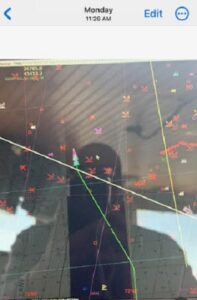 had just passed a juvenile Fin Whale only a few miles off, after leaving the Manasquan inlet. Bill knew the Whale he was watching near the Go Discovery was not acting in any way he had ever observed in his 30+ years of fishing and was aware of the controversial issue of research vessels and the recent Whale strandings. Here was possible evidence of a Whales reaction to either the sonar or seismic equipment the Go Discovery was using, as the whale was making a frantic beeline away from the Go Discovery. The Holdfast continued on its course, southeast towards the offshore grounds and Bill kept track of the animal for a good twenty minutes before it was no longer in sight, behind him. He noted that the Go Discovery seemed to have spotted the Whale and turned away from it. He took pictures of his AIS screen to note the location of both vessels, and time. The location is shown on the screen in Loran C numbers.
had just passed a juvenile Fin Whale only a few miles off, after leaving the Manasquan inlet. Bill knew the Whale he was watching near the Go Discovery was not acting in any way he had ever observed in his 30+ years of fishing and was aware of the controversial issue of research vessels and the recent Whale strandings. Here was possible evidence of a Whales reaction to either the sonar or seismic equipment the Go Discovery was using, as the whale was making a frantic beeline away from the Go Discovery. The Holdfast continued on its course, southeast towards the offshore grounds and Bill kept track of the animal for a good twenty minutes before it was no longer in sight, behind him. He noted that the Go Discovery seemed to have spotted the Whale and turned away from it. He took pictures of his AIS screen to note the location of both vessels, and time. The location is shown on the screen in Loran C numbers.
On the offshore fishing grounds, dozens of commercial fishing boats were out taking advantage of a welcome break in the winters bad weather, with most of the boats around the Hudson Canyon area seeking, Summer Flounder, Scup, and Black Sea Bass. The surface of the water was teeming with Dolphins, many of which charge the boats when they haul their gear back to get an easy meal. Pilot Whales are especially abundant this time of year, and have been observed changing direction and swimming towards commercial boats the minute they hear the boat slow down and put their power take-off in gear. The change in the sound from the engine, and the PTO is like ringing the dinner bell to pilot whales who sometimes come right up to the boat as the cod end is being brought on board and stick their heads out of the water to observe the boat and crew, while looking for any fish that slip through the nets mesh. Crewman James Lovgren noted that many times this trip they had over fifty dolphins swimming near the boat during haul-backs. Less then fifteen miles from the Hudson grounds, the research vessel Go Explorer was busy surveying in the Texas Tower area where they had been working recently. Few vessels bother trying to fish near them as according to Captain Lovgren, you can’t catch a fish within four miles of these vessels when they are working, the noise scares them away.
The observation of the Whale by the Holdfast is uncommon in that most commercial vessels working offshore do their traversing during the night, as that is when fishing is slowest, so they cannot see any surface activity unless there is a bright moon in the sky. The actions of the Whale, believed to be a Humpback, fit into what the government would call Level two harassment, which includes noticeable reactions by the animal, that may lead to serious injury, but not death. That would be Level One harassment. The Whales behavior is a not a feeding pattern or style, Humpback Whales eat only during the four months when they are feasting in the cold artic waters during the summer time. The rest of the year they live on their fat reserves which they count on to allow them to migrate thousands of miles using those fat reserves. Forced changes in the migratory path of whales results in a loss of essential fat reserves, and are known to cause miscarriages, starvation, and loss of young calves.
The slapping of the Whales Tail is a loud warning to other whales of danger and can be heard underwater for miles. The day after the video was taken, eight Dolphins beached themselves at Sea Isle New Jersey, and died or were euthanized. A number of offshore wind vessels were surveying within twenty miles of the shore adjacent to the stranding area. The government and its apologists have adamantly denied any connections of the wind survey work with the recent spate of marine mammal strandings, they are now going to try to blame the deaths on avian bird flu. Maybe Anthony Fauci can help them with their propaganda campaign.
A footnote! Bill Lovgren took a short video of the whale on his cell phone, and we’re having an issue bringing it here, for now. The image was taken from the video. Borehead

The Whale slaughter continues, but is this just the beginning? By Jim Lovgren
Another Humpback Whale washed ashore on a New Jersey beach on March 1st , the 12th known Whale to die since the start of December, along the New York, New Jersey shoreline, coincident with multiple research vessels using active Sonar, seismic Pingers, and Ultra High Resolution Seismic sparkers. As more research vessels ply our waters, more dead Whales wash up on the beach. This is just the start of the gigantic ecosystem changing industrialization of the US continental shelf from the Gulf of Maine to Florida. We now have 23 dead Whales on the east coast within a three month period, and despite what government officials claim, it is not a normal amount. >click to read< 07:55
The Whale slaughter continues, but is this just the beginning? By Jim Lovgren
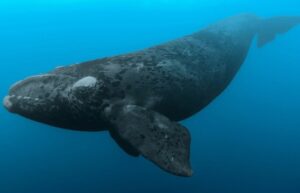 Another Humpback Whale washed ashore on a New Jersey beach on March 1 st , the 12th known Whale to die since the start of December, along the New York, New Jersey shoreline, coincident with multiple research vessels using active Sonar, seismic Pingers, and Ultra High Resolution Seismic sparkers. These are different types of equipment used to map the seafloor by Wind and oil companies, which emit loud sound pulses over 200 dBs continuously around the clock, that can travel hundreds of miles underwater.
Another Humpback Whale washed ashore on a New Jersey beach on March 1 st , the 12th known Whale to die since the start of December, along the New York, New Jersey shoreline, coincident with multiple research vessels using active Sonar, seismic Pingers, and Ultra High Resolution Seismic sparkers. These are different types of equipment used to map the seafloor by Wind and oil companies, which emit loud sound pulses over 200 dBs continuously around the clock, that can travel hundreds of miles underwater.
While the damage caused by Naval high powered active sonar, both mid and low frequency, is documented and admitted by the US Navy, the use of lower powered active sonar [both low and mid frequency] has not yet been linked to marine mammal strandings. Of course the US government has not funded any research into this issue, so that they can claim no evidence of a link between strandings and the use of this lower powered active sonar. Active Navy sonar operates at a level of 230 to 240 dBs one meter from its sound source and any unfortunate animal to be within 50 feet of operating Navy sonar will die a horrible death as its internal organs turn to mush by the powerful sound waves. The lower power sonar used by the research vessels creates sounds in the low 200 dBs range, which while not powerful enough to kill immediately, may kill indirectly due to its constant 24 hour a day usage, by a number of different boats within the New York Bight area. The government’s claim that there is no evidence that the research vessels noise-making sonar, or seismic sparkers are linked in any way to the recent Whale strandings, is being put to the test with each Whale death.
As more research vessels ply our waters, more dead Whales wash up on the beach. This is just the start of the gigantic ecosystem changing industrialization of the US continental shelf from the Gulf of Maine to Florida. The Biden administration’s stated goal of 30 gigawatts [GW] of offshore wind power by 2030 means that there will be over 3,400 individual wind turbines permanently occupying over 2,400,000 acres of ocean bottom. Once operational, they will form an imposing gauntlet of noise, vibrations, and electro-magnetic fields that marine mammals, turtles, fish, and birds will have to migrate through. This is especially critical in the area east of Rhode Island to south of Nantucket where the lease areas stretch from shoal waters to far offshore and has been designated as critical habitat for the endangered Northern Right Whale. If they want to avoid the noise of an operating wind farm they will have to swim in the inshore shipping lanes, where they suffer their most fatalities, or farther offshore
where food sources may be scarcer or even non-existent while having to navigate through the maze of offshore lobster and crab buoy’s.
In a recent Coast Guard notice to mariners for two CG districts in the New York bight it was announced; “TerraSond will be conducting geophysical survey activities within the Bluepoint Wind lease area [OCS-A 0537], 38 nautical miles [nm] off the coast of New York and 53 miles off the coast of New Jersey, from March 1 through September 30, 2023, 24 hours a day, seven days a week. Equipment on scene will be the GO Adventurer survey vessel, utilizing sidescan sonar, multibeam bathymetry echo sounder, cesium vapor magnetometer, parametric sub-bottom profiler, and ultrashort base line acoustic transceiver.”
There are dozens of these vessels and their support ships presently operating off the east coast all using high powered sonar and seismic equipment. The use of the dreaded seismic air guns has been replaced by the kindler, gentler Sparkers and pingers, which generate seismic sound by an electrical
charge as opposed to the air gun’s compressed air discharge. While the air gun arrays create noise at the 240 to 250 dBs level at the source, the sparkers noise is lower, operating in the 200 to 210 dBs range. Used in low frequency’s this sound can travel hundreds of miles in a spreading pattern which loses strength the farther from the source it travels. Since there are presently anywhere from 3 to 6 research vessels presently using either sonar or seismic equipment from Cape May to Nantucket Island it stands to reason that the complete continental shelf of the Mid Atlantic/Southern New England region is blanketed with some level of sonar or seismic noise. With other research vessels working from South Carolina, north into the Gulf of Maine the whole east coast is being blanketed by more underwater noise than ever before, all along the migratory paths of multiple endangered species.
Since marine mammals rely on hearing to feed, navigate, avoid prey, and mate, the intrusion of so much man made noise in such a short period of time is bound to be physically harmful to these sound sensitive animals. [read “Impacts of Navy sonar on Whales and dolphins : Now beyond a smoking gun? E.C. Parsons”] If a Whale is in an area where seismic or sonar is being used it will affect his ability to hear and communicate, and likely trigger a flight response, expending valuable fat reserves while doing so. An analogy; you and a friend go out to diner at a local restaurant that seats fifty people. There are six other people in the room at different tables and you and your friend can have a pleasant conversation. But as more people are seated the background noise starts getting louder, and you find yourself having to repeat statements because your friend can’t hear them. When the room is full, you can no longer hear each other from the accumulated amount of noise echoing from wall to wall. After sufficient noise
harassment, you ask for the check and leave. Whales don’t really have a way to leave their annual migratory path, its ingrained in them, and even small changes in a Whales migratory path can expend so much energy that it causes the animal physiological harm.
We now have 23 dead Whales on the east coast within a three month period, and despite what government officials claim, it is not a normal amount. A number of those deaths coincided with the operations of the RV Fugro Enterprise, which has multiple different sonar’s, and also features a GeoAcoustics 5430/5210 Sub Bottom Profiler, also known as a seismic pinger. The timing of strandings with the Fugro Enterprise operations has been documented by use of the AIS vessel tracking system. Presently geophysical surveying has been finished or is ongoing in about one third of the leased wind sites on the east coast.
When surveys in one area are completed, the research vessels move on to a different lease site, as the demand for these specialized vessels is presently intense. In their place come the construction crews, vessels, barges, jacking platform, ships, etc. all preparing for the loudest assault on the
environment, the pile-driving part, where a 150 to 200 ton hydraulic “hammer” is dropped onto the anchor pile, driving it repeatedly further into the seabed with each timed 250 dBs loud drop. One of the loudest man-made underwater sounds there is. Not to worry though, that sound will be mitigated, by a “Bubble curtain” which will trap the sound and reduce any harm to nearby animals, so say the bureaucrats who also claim no connection of sonar to the strandings. Regarding underwater sound mitigation techniques, quoting from, [Parsons et al, 2009] “It may be a long time before technology and methods are easily available to answer the many still unanswered questions about the exact nature and degree of the impacts of sound on cetaceans, especially when we know that many of the mitigation measures in place for protecting cetaceans against the impacts of sound are untested “best guesses” or indeed, are known to be ineffectual.”
While the pile driving is going on, the sea bed will be carved into trenches so they can bury 6,800 miles of undersea high voltage cables which connect the turbines to the substations and then to shore, utilizing a whole other type of construction vessel and further increasing vessel traffic. Eventually some of the turbines will start working introducing a new sound, plus the vibrations of the turbine itself into the marine environment. Electro- magnetic fields will be created around the turbines, substations, and the buried cables under the seabed which will affect benthic animal movements and migrations. This will go on for decades. The slaughter has just begun.

NOAA and BOEM; Ignorance is Bliss. By Jim Lovgren
For about twenty years the Natural Resources Defense Council [NRDC] engaged the US Navy in a legal battle over the effects of the Navy’s use of Mid Frequency Sonar in training exercises and its impact on marine mammals and other creatures, with one case even reaching the US Supreme court. While there are many different aspects of NRDC’s legal actions, the results of the litigation have produced an enormous amount of scientific data and research regarding the effects of underwater sound on marine creatures, with an emphasis on Sonar and marine mammals. They forced the Navy to admit that their use of sonar had resulted in the unintentional mass strandings of many different marine Mammals in a dozen different instances around the world, primarily involving Beaked whales, that are classified as being low to mid frequency cetaceans. >click to read< 08:48
NOAA and BOEM; Ignorance is Bliss. By Jim Lovgren
 For about twenty years the Natural Resources Defense Council [NRDC] engaged the US Navy in a legal battle over the effects of the Navy’s use of Mid Frequency Sonar in training exercises and its impact on marine mammals and other creatures, with one case even reaching the US Supreme court. While there are many different aspects of NRDC’s legal actions, the results of the litigation have produced an enormous amount of scientific data and research regarding the effects of underwater sound on marine creatures, with an emphasis on Sonar and marine mammals. They forced the Navy to admit that their use of sonar had resulted in the unintentional mass strandings of many different marine Mammals in a dozen different instances around the world, primarily involving Beaked whales, that are classified as being low to mid frequency cetaceans. These mammals communicate, navigate and feed using low to mid frequency sounds. While this series of lawsuits resulted in the recognition of the harm that high powered Sonar can cause to marine creatures, it did not address the issue of the damage that lower sound levels can cause. This also coincided with a growing recognition that the amount of human caused noise in the natural marine environment was reaching a dangerous level, and was having impacts on the creatures that reside there, which may be worse that many of the more visible signs of pollution.
For about twenty years the Natural Resources Defense Council [NRDC] engaged the US Navy in a legal battle over the effects of the Navy’s use of Mid Frequency Sonar in training exercises and its impact on marine mammals and other creatures, with one case even reaching the US Supreme court. While there are many different aspects of NRDC’s legal actions, the results of the litigation have produced an enormous amount of scientific data and research regarding the effects of underwater sound on marine creatures, with an emphasis on Sonar and marine mammals. They forced the Navy to admit that their use of sonar had resulted in the unintentional mass strandings of many different marine Mammals in a dozen different instances around the world, primarily involving Beaked whales, that are classified as being low to mid frequency cetaceans. These mammals communicate, navigate and feed using low to mid frequency sounds. While this series of lawsuits resulted in the recognition of the harm that high powered Sonar can cause to marine creatures, it did not address the issue of the damage that lower sound levels can cause. This also coincided with a growing recognition that the amount of human caused noise in the natural marine environment was reaching a dangerous level, and was having impacts on the creatures that reside there, which may be worse that many of the more visible signs of pollution.
The efforts of NRDC regarding the damaging effects of Naval sonar has saved the lives of many marine creatures by forcing the Navy to comply with the many US laws that protect the environment. They have become one of the worlds leading experts on the effect of noise on marine mammals, yet
curiously they remain silent on the issue of the recent strandings of Whales along the US east coast, as coincidently research vessels using low frequency sonar have inundated the area for geological mapping of the seafloor and substrates for industrial wind power turbines. A group that was so concerned about saving the Whales from underwater noise, has conveniently forgotten their concern because that noise is created by vessels employed by wind companies. Those companies and the US government have worked in unison to deny any link at all between the recent strandings and the work being done for offshore wind development. High level US officials have categorically denied that there is any evidence of the noise being produced having a detrimental effect on marine mammals despite decades of work in regard to the harm being caused by human produced noise in the marine environment. Existing science suggests the link is there.
In a paper by NRDC’s Joel Reynolds, titled “Submarine’s, Sonar, and the death of Whales”, published by William and Mary Environmental Law and Policy Revue [vol. 32:759] in 2008, Reynolds writes; “There is no longer a serious scientific debate about the connection between sound and marine
mammal mortality. A range of experts, from the international Whaling Commission’s {IWC} Scientific committee [2004 report] to the U.S. Navy’s own commissioned scientists, have agreed that the evidence linking mass strandings to mid-frequency sonar is “convincing” and “overwhelming”. Consultants retained by the Navy concluded that the evidence of sonar causation is in our opinion, completely convincing and that therefore there is a serious issue of how best to avoid/minimize future beaching events. Potentially related strandings have occurred repeatedly around the world, with stranded animals found with bleeding around the brain, emboli in the lungs, and lesions in the liver and kidneys, symptoms resembling a severe case of decompression sickness, or the “bends”. Because these injuries occurred in the water, before the animals stranded, scientists are concerned that Whales turning up on shore may represent only the tip of the iceberg, with substantially larger numbers dying off-shore. Other sources of noise, such as the airguns used in seismic surveys, may have similar effects.”
The paper also has this statement; “Though a prominent focus of public concern and reporting in the media, these stranding events represent only one manifestation of injury related to exposure to intense noise. Indeed, it is the cumulative impact that these stressors have on the behavior of marine mammals, particularly in already depleted populations, that may pose the greatest threat; what has been called a “death of a thousand cuts”. Because marine mammals depend on sound to navigate, find food, locate mates, avoid predators, and communicate with each other, flooding their habitat with high intensity, anthropogenic noise poses a substantial risk of interference with these and other activities”. Footnoting this point; NRDC’s Michael Jasny, quoted Dr. Sylvia Earle’s “death of a thousand cuts “, and stated that “preliminary attempts at modeling the energetics of marine mammals [the amount of energy an animal has to spend to compensate for an intrusion] suggest that even small alterations in behavior could have significant consequences for reproduction or survival if repeated over time”.
Further in the document are these statements; “Also in November 2005, the parties to the Convention on Migratory Species [CMS] passed a resolution naming marine noise among six human threats to cetacean populations. The resolution calls on the CMS’s Scientific Council to assess whether marine noise is adequately addressed in the convention’s threat abatement activities.”
“The UN General Assembly established an “Ad Hoc Open-Ended Informal Working Group to study issues relating to the conservation and sustainable use of marine biological diversity beyond areas of national jurisdiction” [i.e. on the high seas] In February 2006 that working group convened its first
meeting, where it recognized ocean noise as a “growing human pressure” that requires urgent action through international cooperation and coordination.”
Lastly, starting off the recommendations section of the paper is this; “The accumulating scientific evidence of noise-induced harm, including mass strandings of marine mammals around the world, is a wake up call to a significant environmental problem. While its complexity precludes a simple
or an immediate solution, some progress has already been made, both domestically and globally. But much more is clearly needed now, at a point where meaningful and effective solutions can have an impact BEFORE the problem proliferates out of control, it’s causes intractable and it’s impacts
irreversible”.
This last sentence is critical, because we are already near the point where long term damage from the multiple noise sources involved in the production of offshore wind energy is intractable, and its impacts to marine mammal populations irreversible. Extinction is forever.
Many marine mammal species migrate annually along the North American coast and they have had to adapt during their lifetimes to a growing amount of human created noise, some of it deadly. It has created a high stress life for them with a confusing array of sounds including low frequency noise from distant sonar and seismic testing, which can trigger fight or flight responses. Repeated stress responses can be detrimental physiologically to animals and could lead to premature death. The average life span of every species of Whales along the US coast has dropped dramatically in the last few decades, coinciding with the rise in human produced noise in the marine environment. Have Whale species in the North Atlantic reached the tipping point in how much human produced noise they can withstand and still survive, or have they passed the point of no return with the recent introduction of almost relentless noise from low frequency sonar research vessels along the coast?
NOAA and BOEM are closing their eyes to science and scientific protocol in regard to the recent Whale strandings. They ignore a growing mountain of evidence indicating that many species of whales are more sensitive to sound then previously thought, with research showing tagged Cuvier’s beaked
Whales responding to only 89 dB re 1 u Pa. A paper published by Frontiers in Marine Science, entitled; “Impacts of Navy Sonar on Whales and Dolphins: Now beyond a Smoking Gun? By E.C.M. Parsons in 2017 cites numerous recent studies showing Whales sensitivity to sound is greater than believed, and he reasons then that the US harassment levels of sound are far higher than they should be, with TTS and PTS being reached at lower levels then acknowledged. Almost all of the research that’s been done has admitted to not having enough science to be certain of any effects of under water noise but they all urge the use of the Precautionary Principle in regard to its possible effects. This important paragraph highlights that:
“The importance of not delaying conservation action when a concern exists, but scientific data and analysis have not incontrovertibly established the threat exists, i.e. “the precautionary principle”, has been enshrined in a number of international laws [Hey,1991] including the 1992 Convention on
biological Diversity [Principle 15 of the so-called “Rio Summit”]. Because of this level of uncertainty and difficulty in establishing beyond a reasonable doubt trends and threats in cetacean populations, it has been argued that in order to effectively conserve and manage populations one must be precautionary, as otherwise catastrophic declines in cetacean populations could occur before science catches up with the problem”.
We only have one last chance to save the North Atlantic Right Whale from extinction, scientific protocol calls for us to make the most of it. Endangered marine mammals are facing a survival crisis that is complicated by the increase in human made noise, which may even have more population level effects then ship strikes and fishing gear encounters. The sheer enormity of Biden’s offshore wind projects dwarfs in size and scope any previous usages of the marine environment throughout history, its effects are bound to be enormously destructive to the entire marine ecosystem of the east coast. No one should be able to ignore science just because it doesn’t suit their purposes.

“Looking Back; “Fishery management; best available science, or politics?” 2009. By Jim Lovgren
I wrote this piece at the beginning of the Obama administration, concerning the politization of fishery science, over fourteen years ago. The rash of east coast marine mammal strandings and the governments response to them, eerily reminded me of this article and the reasons I wrote it. If you
change a few words, Bush to Biden, and big oil to big wind, you get pretty much the same thing, the politization of science to benefit wealthy corporations. >click to read< 17:05
“Looking Back; “Fishery management; best available science, or politics?” 2009. By Jim Lovgren
Much has been made of the Bush administration’s disdain for science, especially in cases where environmental concerns could have an effect on a wealthy campaign contributing corporation’s bottom line. From the butchering of the EPA’s report on global warming, to the interior department’s political interference on endangered species rulings, the Bush administration has shown an almost total disdain for the environment and the creatures that inhabit it, with one glaring exception, the Ocean. The administration has bent over backwards to curry favor to a well-financed group of
ocean advocates, primarily funded by the PEW Charitable Trusts. The National Marine Fishery Service [NMFS], has conducted its own campaign of politically motivated advocacy science, except in this rare instance the administration has seemingly been trying to protect the environment.
So, lets look a little closer at what’s been going on behind closed doors. First thing to realize is that for the last 8 years “Big Oil” has occupied our White house, and that they will do anything to advance their “obscene profits” agenda. No science is safe, since through the machinations of multi-national corporations, and their controls of virtually all forms of media, Global warming can be dismissed as a slight annoyance. Politically, wars can be justified by false accusations of weapons of mass destruction and not the oil reserves that were the real prize. In the case of U.S. fisheries, it appears that the Administration has attempted to atone for their gross contempt of terrestrial ecosystem concerns by placating the environmental industry by saving the oceans. In reality they are just reducing the monetary liabilities of the oil companies by putting the fishing industry out of business.
If you were the leaders of a multi national oil company that wanted to drill on the US East coast, how would you do it? Obviously you would have to remove the impediment’s to drilling, the Fishermen, and the environmentalists. First, you need to establish a seemingly unbiased funding mechanism to promote your goals. That’s where the PEW charitable trusts come in, a multi billion dollar non profit, with a seemingly spotless reputation, that was established by Joseph Pew. Coincidentally, Joseph Pew was the founder of Sun oil company, and that is where all the foundation money came from.
PEW claims that they have no connection to big oil anymore, they are just a public policy advocacy group. They don’t mention that half the Board of Directors are Pew family members, and you can bet their investment portfolio is heavily invested in oil stocks. To say that the PEW foundation has no relation to big oil is like saying the Swift boat veterans group were not funded by republicans. Using an octopus array of splinter groups to disguise the true source of the funding, Big oil has funded Swift boat attacks by a myriad of ethically challenged “environmental groups”, [ who were only to glad to grab the money], to target overfishing, using PEW funded advocacy scientists who will say anything for a dollar. They also pay a very efficient publicity firm to spread the “news” to the media. Next, to add some real punch to the plan create an Ocean advocacy group and engage a diverse group of mostly uninformed “experts”, and write an all encompassing paper describing the global threats to the ocean ecosystem, but conveniently relegate the disastrous effects of oil drilling and spills, to a tiny afterthought, despite thousands of pages of otherwise excellent material. But if you really want to put fishermen out of business, use the government to do it.
The National Marine Fisheries Service is located in the outhouse on the hill behind the Commerce Department building. They will march to whatever orders come from headquarters. Since the Bush Commerce Department was dominated by Multi national industry concerns, political agenda’s have driven science. In this case, that agenda was to allow oil drilling on the U.S. continental shelf, in area’s that have been off limits to drilling for over 25 years. In the waning days of the administration they have gotten their wish, the drilling ban has been lifted. Soon the oil companies will be free to
despoil the marine habitat of the U.S. east coast so that they can recover the estimated 600 million barrels of oil beneath it. Did I mention that this year those same oil companies exported over 600 millions barrels of U.S. produced oil to foreign nations? Seems to me that we wouldn’t have to drill here if we kept our oil reserves in our own country. Besides the potential damage to the fishing industry, and the ecosystem that oil spills and drilling mud’s would cause, the East coast tourism industry would be devastated. Despite one of the largest coastlines in the continental U.S. nobody goes to
Texas to enjoy the beaches, who wants to walk on tarballs? Is this what east coast states want?
Here’s where connections in the Commerce department come in handy. Have your PEW funded minions lobby congress to change the National Marine Fishery Service from an agency that worked to promote a healthy and sustainable fishing industry, into an agency that wants to turn the ocean into a petting zoo. Get the Science centers to create biological targets that are higher then anything ever observed for each species, and then demand that those targets be reached by each species at the same time, a biological impossibility. The scientists know this is an impossibility, yet they claim it can be theoretically accomplished. If you spent eight years in college to get a masters or doctorate degree in fishery population dynamics, you would say anything the government told you to say, because they are your only chance at employment in that field.
It has been clear to any commercial or recreational fisherman on the East coast for years that the government, wants to totally control every movement he makes.[VMS, and AIS tracking devises, overzealous enforcement agents, fishing licenses, etc.]. Part of this can be attributed to the job justification of government workers, the more government workers there are, the more they have to justify their jobs by controlling real workers who
actually produce a product that benefits society. History has shown that there is a value to regulation, [ie, “The tragedy of the commons”]. But regulation can go too far, and become far worse a menace then no regulation at all. Especially when that regulation is based on politically influenced science.
As both a fisherman, and a fishery manager, I heard for years fishermen complaining about what they believed to be unjust regulations, because the science was created by people who had no clue about how many fish were in the ocean, they just biannually made their random survey tows, at the wrong time of the year, with obsolete fishing nets, and out of whack towing cables, and then let their mathematicians prove whatever the Department of Commerce wanted proved.
So how bad has the science coming out of Woods Hole, [Northeast Fishery Science Center] been in the last eight years? I’d personally love to subpoena a few scientists and see what they think under oath, because some of the science is so bad that the scientist’s are either incompetent or they have no integrity. It is so bad in the North East that the fishing industry has had to hire their own scientists to develop alternate science to dispute the government’s findings. In each of the three fisheries in question, Scallops, Monkfish, and Summer Flounder, the government’s science was found to be sadly deficient. These three fisheries are among the five most valuable Fisheries on the East Coast, and the mismanagement of them has cost the economy hundreds of millions of dollars already. NMFS has a huge annual budget, you would think for the money they spend that they could create accurate science to manage a multi billion dollar fishing industry in a sustainable way. Sadly with less then a million dollars of capitol, the
commercial and recreational fishing industry has proven how poorly the science was for three critical species. Woods Hole has gone from being the most respected marine science center in the world, to being a joke, a bad one at that.
So lets look a little closer into just what exactly, the NMFS and its partner in crime the NEFSC has been up to in regard to helping their parent agency and its wealthy benefactors in their quest for oil. Ecosystem management has received much attention in the last decade as efforts to rebuild fish stocks have taken on increased public awareness. The carrying capacity of an ecosystem is the total amount of animals that can be biologically sustained within that ecosystem. There are natural highs and lows of different marine populations, usually caused by environmental conditions, and there are also manmade highs and lows such as the well-documented Groundfish / elasmobranches regime change on the Georges Bank. One thing is certain about ecosystem carrying capacity, there is an upper limit to how much biomass can be sustained, and this is predicated on how much food is available. The composition of the species can and will change, but they cannot exceed the carrying capacity without causing a collapse.
Our management system is based on biological targets that are set for each species that our councils manage. These targets are formulated by the fishery science centers using various complex mathematical equations to come to an educated guess of how many fish of each species should be in the ocean. The problem is that it is physically impossible for any ecosystem to sustain the rebuilt populations of every fish species at the same time, unless of course, the rebuilding targets are realistic and account for the natural fluctuations of nature. In the case of the Northeast region’s fisheries, the biological targets of many of the managed species are based upon the three-year moving average of the highest observed populations of these species based on the annual trawl surveys. Ask any scientist at the NEFSC if they think it is possible to have all of our fish stocks recovered to the present Biological targets at the same time, and they will tell you; it is impossible. Yet this is what we are trying to do. There are presently over a billion
pounds of spiny dogfish swimming around off the US east coast, three times more then were present in an unfished population in the 1960’s, yet we are forced to “rebuild” the population to a level that is unsustainable unless other stocks are not allowed to rebuild. By law that is impossible, the stocks must be rebuilt within a certain time frame or fisheries must be shut down. This whole system ignores the basic tenet of ecosystem carrying capacity. There simply would not be enough food to feed all of the fish that the NMFS insists should be in the ocean according to their unattainable biological targets. If it’s a consensus opinion of the scientists about the inability to have an ocean full of every species at the same time, then we are not dealing with management by science, but with management by policy.
NMFS insists on ignoring best available science when it comes to biological targets in relationship to ecosystem carrying capacity, yet they are required by law to use it. That is National Standard #2. The fact that they insist on attempting to reach all of these targets at the same time without acknowledging their impossibility or attempting to figure out rational targets in relationship to ecosystem management, and the corresponding carrying capacity of the ecosystem shows a complete disdain of the fishing industry that must suffer the economic consequences of this policy. This is also ignoring a National Standard, and that is National Standard # 8 ‘Conservation and management measures shall, consistent with the conservation requirements of this act [including the prevention of overfishing and rebuilding of overfished stocks], take into account the importance of fishery resources to fishing communities in order to {A] provide for the sustained participation of such communities, and {B] to the extent practicable, minimize adverse economic impacts on such communities.
So lets look at NMFS poster child for criminal mismanagement, Spiny Dogfish. Using the NMFS own science, we know that the total biomass of dogfish on the US east coast was around 150,000 MT in the 1960’s, and this was as close to a virgin population as you can come by. By the early 1990’s the population had increased to over 500,000 MT [over 1.2 billion pounds], as Dogfish and skates replaced the overfished Groundfish
stocks on the Georges Bank. The displacement of the valuable groundfish species was documented by the NEFSC own Steve Murowski and he stated in his paper, “Multi species size composition: A conservative property of exploited fishery systems?” “Given the current high abundance of skates and dogfish, it may not be possible to increase gadoid and flounder abundance without “extracting’ some of the current standing stock”. This paper was written in 1992 and a highly effective dogfish and skate fishery developed. [I might add that the little skate population also tripled from 1978 to 1990,
and the biological target was set at the highest level for this species also, although they prey on the same food stuff as many groundfish species]. The fishery that developed targeted primarily large females, those dogfish over 80 cm. long, as they were most desired by the market. During the 1990’s the spawning stock biomass,[SSB, mature females] of Dogfish dropped from 200,000 MT to 50,000 MT causing a chorus of howls about the imminent extinction of Spiny Dogfish. This although the total biomass remained above 400,00 MT, twice that of the 1960’s, while the SSB was actually at the
unfished level of the 1960’s. At the council level when creating a biological target was discussed, [there still is none], NEFSC brazenly omitted the population levels from the 1960’s and told the councils that the population was always at the 1980’s level. The council was also told that dogfish eat primarily jellyfish. When I pressed that issue they admitted that they ate a few fish. Almost every study known to man shows the dogfish to be a voracious predator of bony fishes. [ up to 80% of their diet]. Even as recently as this summer, at the spiny dogfish forum a NEFSC scientist told the audience that the dogfish population was always at the high level it is now at. This is not only providing misleading information, it is outright lying. Also at that forum Dave Pierce’s presentation brought to light not only how extensive dogfish predation was on other fish species, but also by
implication how NMFS has hid the information from the management councils. In a paper by J.S. Link, L.P. Garrison, and F.P. Almeida, called “Ecological interactions between elasmobranches and groundfish species on the northeastern U.S continental shelf: Evaluating predation” published in the North American Journal of fisheries management in 2002, it was disclosed that dogfish predation was almost 20 million summer flounder [ages 0 to 1] for the year 1998. That is close to half of the average annual recruitment of that species. Never once was that figure disclosed to the Mid
Atlantic Fishery Management council, despite the controversy surrounding the potential shutdown of that important species because of the stock not being able to reach its 2 times larger then ever observed Biological target. Yet every year, NMFS was at the management table claiming that retrospective analysis showed a large unaccounted for summer flounder mortality that must be blamed on commercial fishermen’s illegal landings or discards.
Over and over again managers heard how Dogfish were the most studied shark in the ocean, and that due to the depletion of the SSB dogfish would not recover for more then a generation. The most optimistic projections, using zero fishing mortality showed the earliest the stock would recover would be 2018. Most projections put the year to be at least 2030, one even showed never. Yet here we are in 2008 and the stock has miraculously been rebuilt in 7 years despite a continued fishery, and discard mortality of 20 million pounds a year. Conveniently ignored was the well studied case of the North west pacific Dogfish which was intensively fished to depletion in the late 1940’s, yet was healthier then ever by 1960. Scientists there discovered that the population would double every 8 years. Around 2003 the NEFSC put a new twist into the dogfish dilemma, There was no recruitment of pups, and they are smaller then normal,, OH MY GOD THE SKY IS FALLING! Totally ignoring density dependence science, [maybe the stock knows there are already to many of them, so they slow their reproduction so they don’t compete against themselves], Armageddon projections showed the stocks collapse and close to extinction within our lifetime. Although fishermen, argued that the trawl survey was missing these fish since they spend most of their early years in waters deeper then 100 fathoms, and the annual surveys only made a handful of tows in that water, this unfounded science became part of the rebuilding plan. I could spend hours pointing out different cases of bad science causing bad management, but Dogfish is the best example, it’s so blatant. How many examples’ can you think of? How can scientists be so wrong? As I said earlier, it’s either incompetence or no integrity.
I believe that criminal actions have been taken by the NMFS to destroy the commercial and recreational fishing industries on the East Coast. When science is doctored to fit a political agenda, wreaking economic devastation to the industries that depend on that science, that is Criminal. These people that have orchestrated this fiasco should be prosecuted. If you feel this way, then send or deliver this article to your congressman and senator, and tell him you demand justice. With a new administration coming in, it is important to know if they really want the truth about fisheries, or if they
will continue the Bush/ big oil agenda. Early returns with the appointment of a recipient of large amounts of PEW oil tainted dollars to the head of NOAA are not looking so good.






